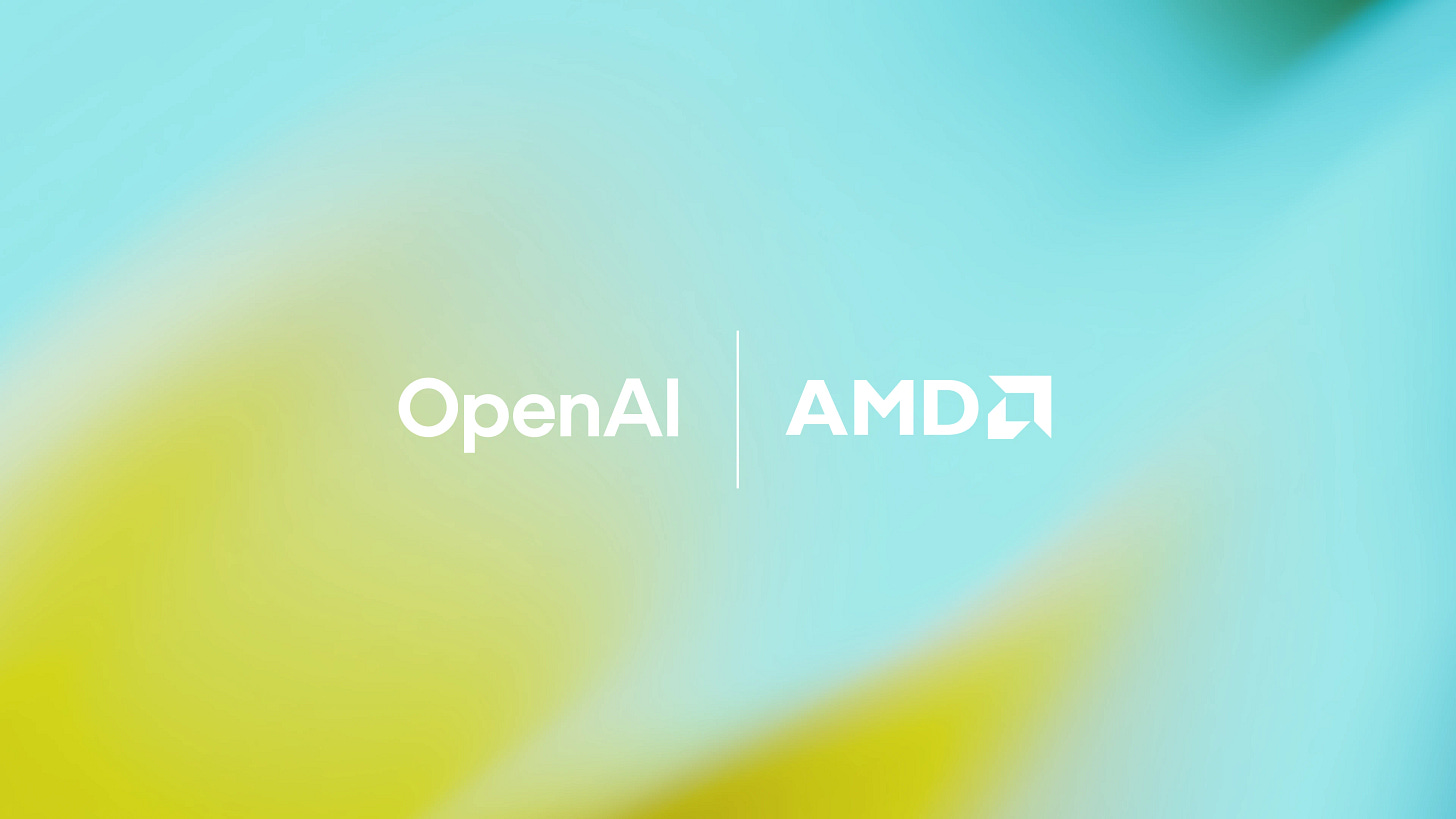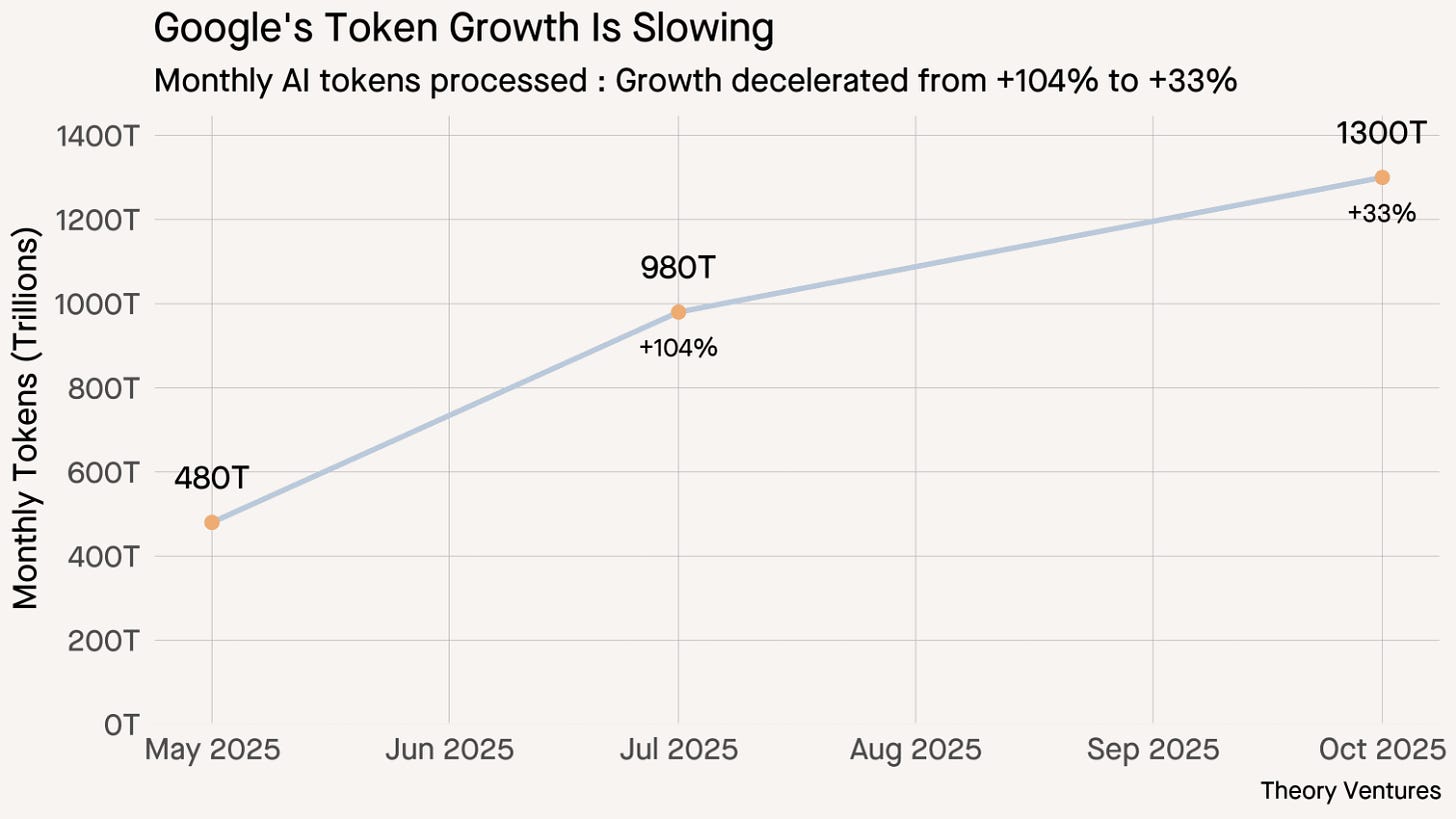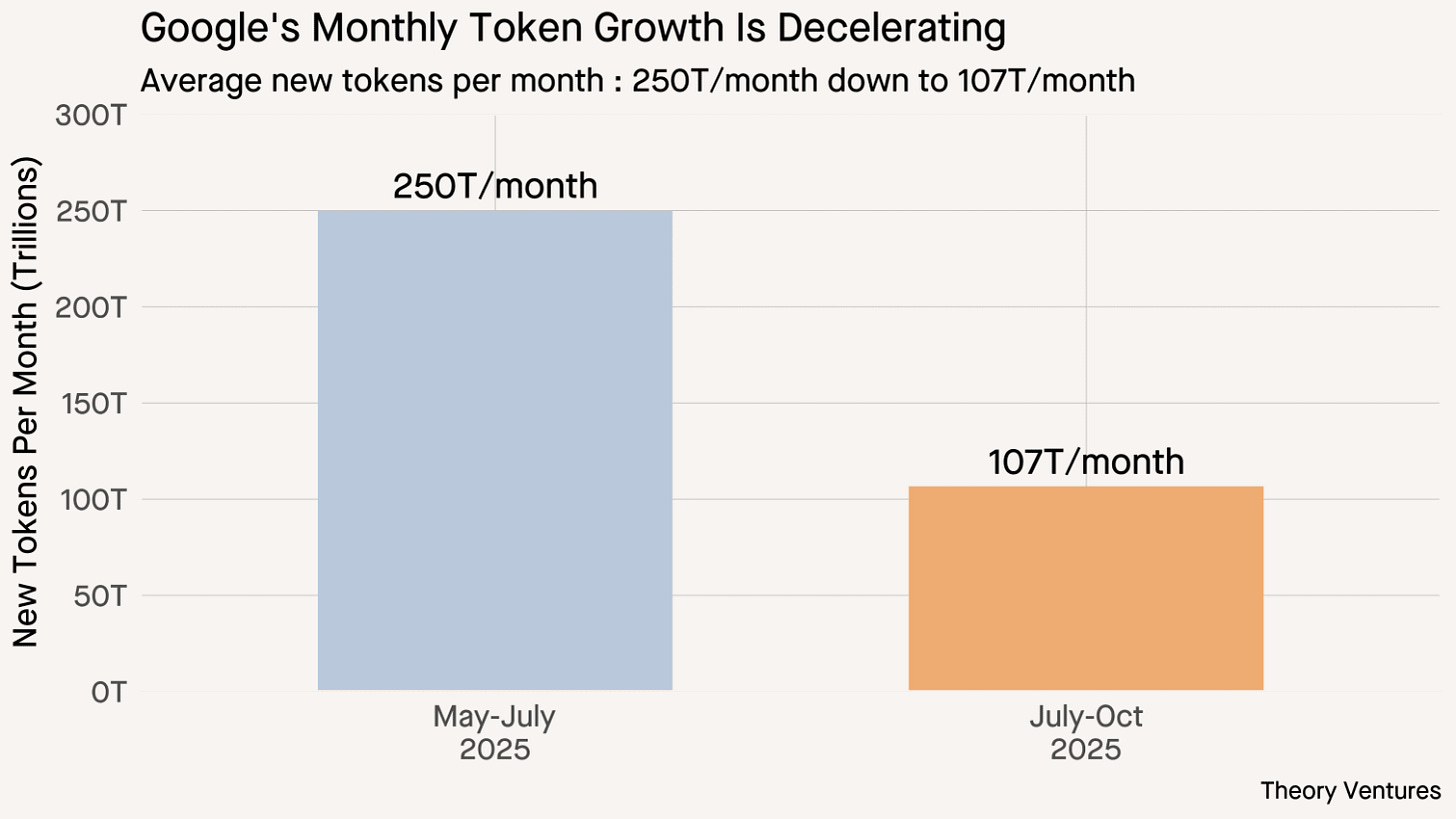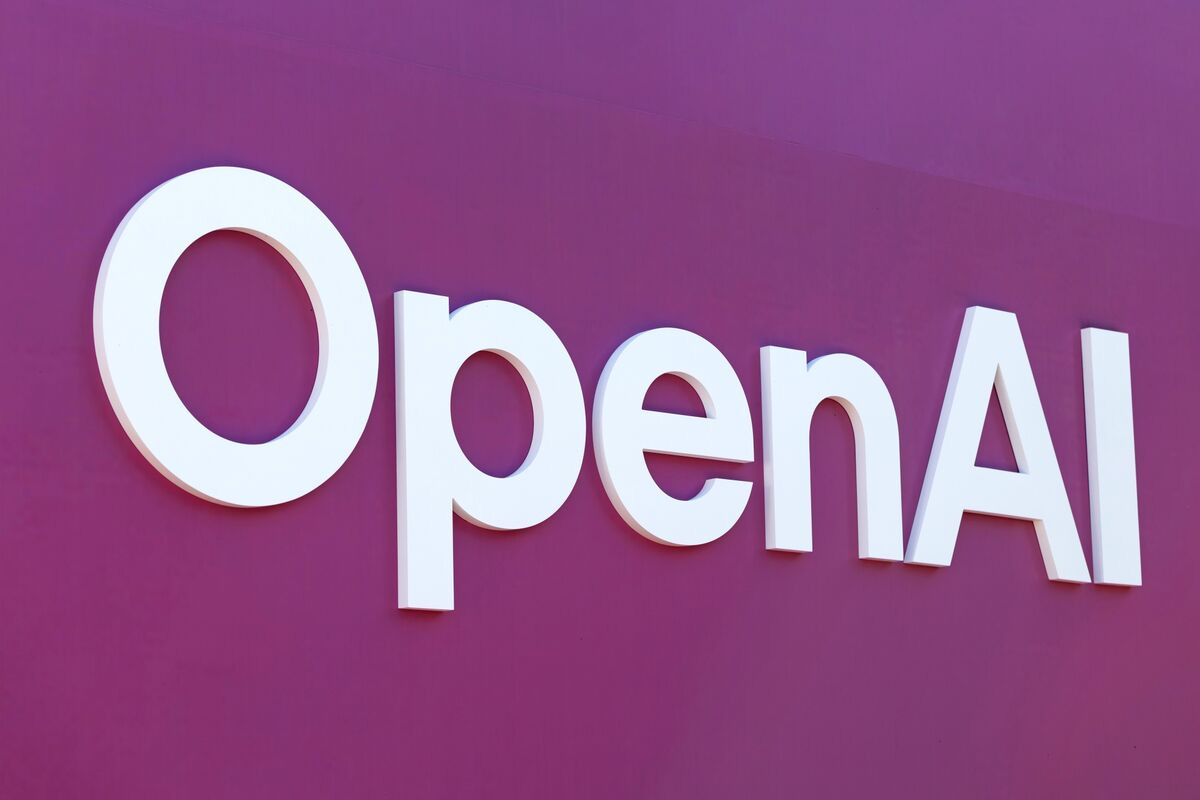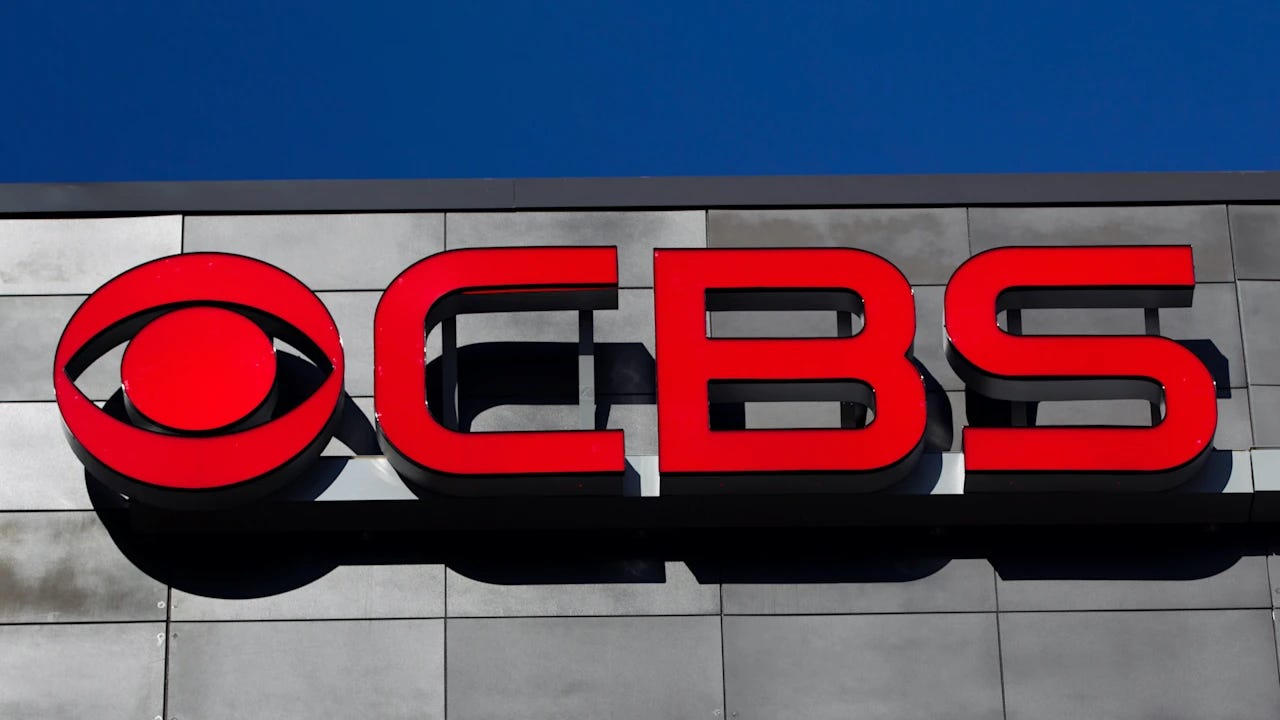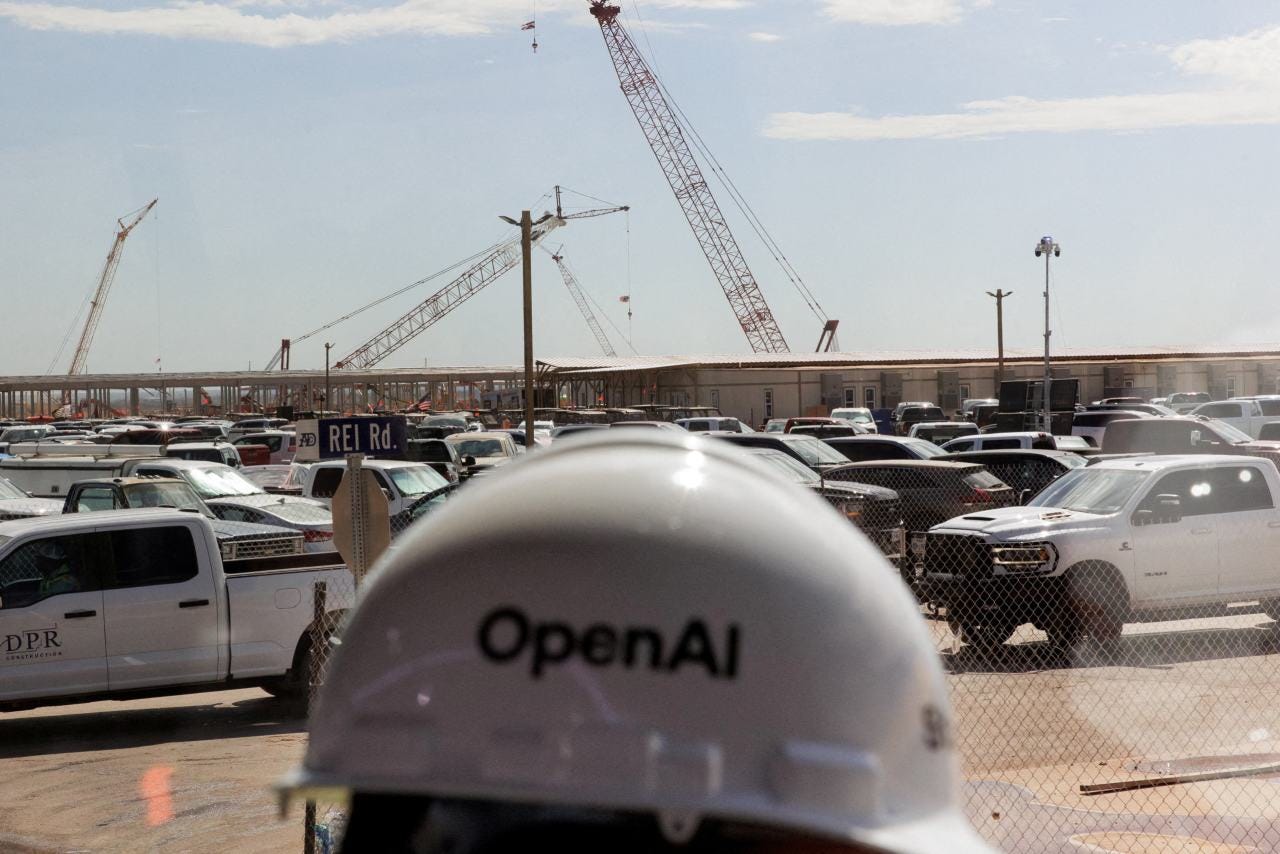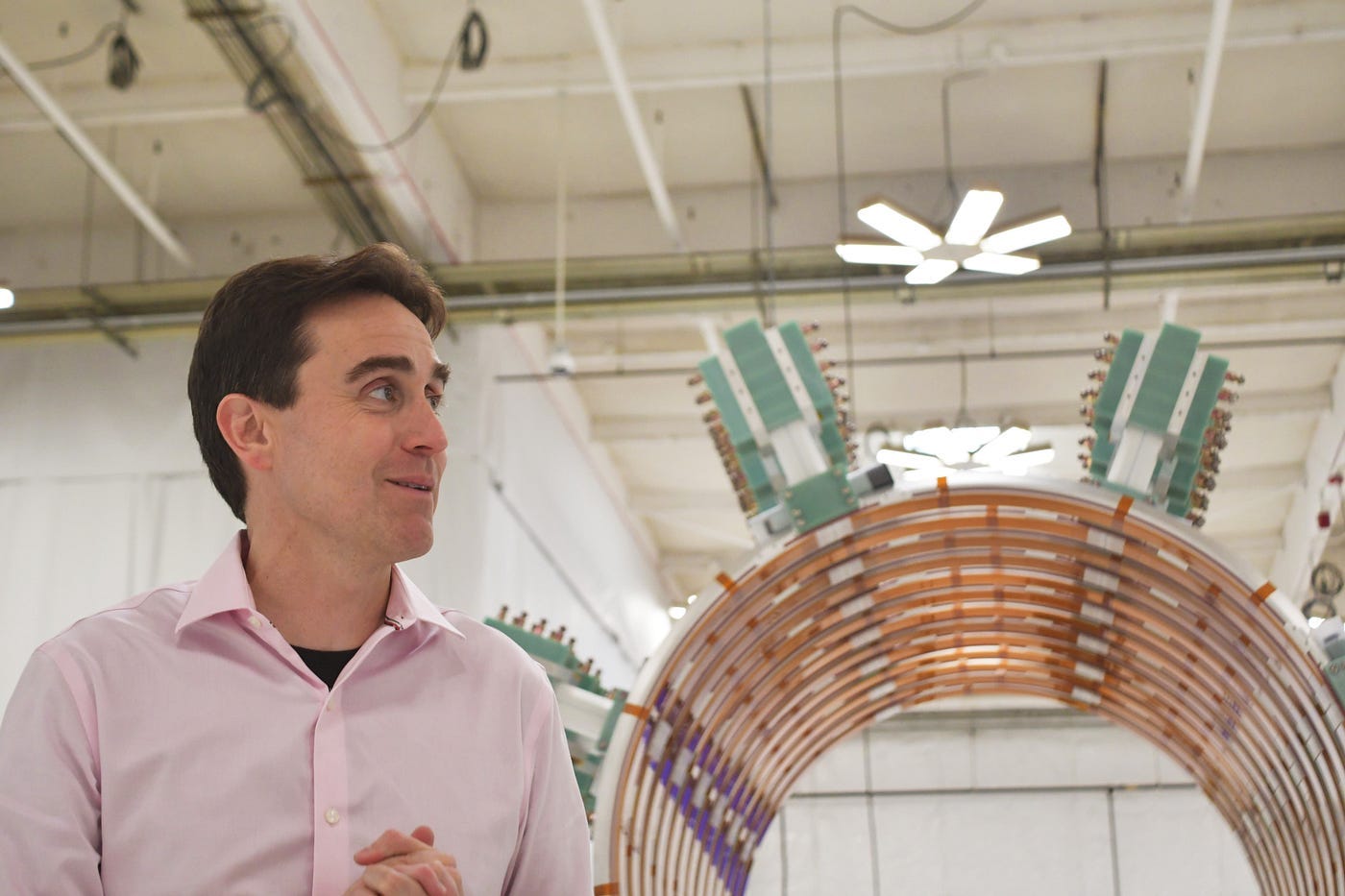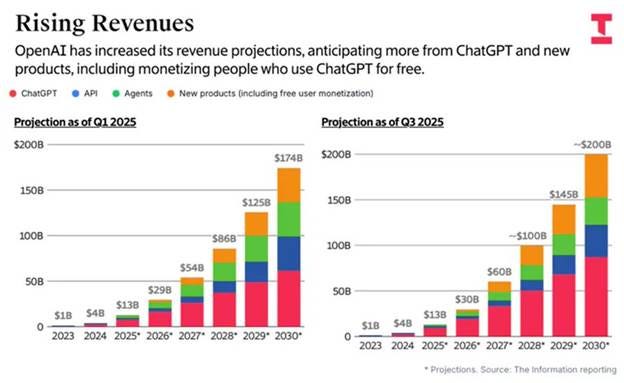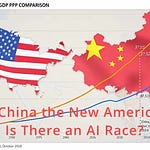Contents
Editorial: Come to Daddy: OpenAI Wants Your Attention
Essay
AI
Media
Venture
Sequoia’s Roelof Botha: Why Venture Capital is Broken & How Great Companies Are Built
Stop Blaming VCs When Your Equity Is Worthless. They Are Just The Enablers.
AI Investors Are Chasing a Big Prize. Here’s What Can Go Wrong.
Sam Altman’s Billion-Dollar Bet on Fusion: The Rise of Helion Energy and the Quest to Harness the…
Concentrating In Winners | Vince Hankes, Partner at Thrive Capital
AI Is Dominating 2025 VC Investing, Pulling in $192.7 Billion
Startup of the Week
Interview Of the Week
Post of the Week
Editorial:
Come to Daddy: OpenAI Wants Your Attention
What happens when one company starts acting like the central bank of compute, the front door to intent, and the rules committee for creative rights—all at once? This week, OpenAI didn’t just ask for our attention. It asked for our grids, our balance sheets, and our defaults. And for the most part it was welcomed by developers and users.
Industrial policy by private contract is here—and it’s wearing an OpenAI hoodie
The “AI Inc” web (coined by the FT below) tightened: a 6‑gigawatt AMD pact with a warrant that could hand OpenAI up to 10% of AMD, a Nvidia LOI to deploy 10 GW with “up to $100B” in staged investment, a reported $300B compute purchase from Oracle, and Stargate’s U.S. campus roll‑out toward 10 GW, with Abilene, TX as flagship. This is not M&A; it’s incentive‑wiring. Capacity becomes destiny because it is all about energy and compute, and financing makes it possible.
“The next leap forward — deploying 10 gigawatts to power the next era of intelligence.” — Jensen Huang
Here’s the tension: Google’s token throughput hit 1.3 quadrillion/month, yet growth decelerated (+250T → +107T added). Meanwhile Citi pegs AI infrastructure at $2.8T by 2029 and the FT warns the capex endgame is in sight. The Perez‑ian retort—“we never know if we’ve built enough until we’ve built too much”—may be right societally, but circular financing across chips, clouds, and labs raises single‑point‑of‑failure risk if any node blinks. OpenAI may lift all boats. Nvidia says it is a demand led expansion, and that is right.
The front door is migrating to agents and creation—and rights are becoming rails
OpenAI is turning chat into an action layer with Spotify and Zillow. Sora moved from demo to economics, promising more granular character controls and a new payout scheme:
“We are going to have to somehow make money for video generation.” — Sam Altman, Sora update 1
That line matters. If the answer layer keeps users in‑product, then licensing, attribution, and settlement must follow the answer—not the click. Hollywood is already behind on AI video; Apple’s Lakers broadcasts in Vision Pro show how quickly formats move when the medium changes. Rights that travel with assets and transparent revenue‑sharing are now product features, not legal footnotes.
Here is my video - accepting the UEFA Champions League as Captain of Manchester United. Yes, that is me.
Trust resets are happening in public—because defaults are policy
CBS installs Bari Weiss and publishes core values; MSNBC releases standards. That’s not just media gossip—it’s a response to the same power shift: when assistants synthesize the news and platforms mediate action, institutions must re‑articulate what they stand for or lose the edge to the interface.
On the build side, Reflection raised $2B to be an open frontier lab, challenging closed incumbents and DeepSeek alike.
But mostly we have over-reactions. Sangeet Paul Choudary’s warning hangs over all of it: hype is capital allocation, and agentic systems atop data‑hoarding models can extinguish user agency. Possibly true. But the capital allocation can also signify a new technical revolution, propelling humanity to new heights like the agricultural and industrial revolutions. Indeed, that seems very likely. And the value created by this new human invention will likely return a lot more capital than it consumes.
Norman Lewis (a good friend) in one of the Essays this week makes the point that the decline in the authority of human institutions is reinforced by a technocratic faith in AI. It’s a good essay and right about institutions. But I don’t think technocrats are the problem, rather the anti-tech lobbies.
I prefer the A16Z essay about the end of post modernism and its replacement by optimism and big thinking, especially predictive thinking.
The obvious AI overbuild will be productive if we pair it with human gains and measurable outcomes. Growth of GDP, lower working hours and days, increased human freedom of choice about how to spend time. These are the outcomes it can make realistic.
What to watch next
The narrative aboput “round trip” cash, implying a suspect use of money between incumbents. Its wrong, but the anti-tech mood of the times is fueling it.
Google’s tightrope: How much screen real estate do AI summaries take—and what’s the publisher payout model behind them?
Sora’s revenue share: Do granular character controls reduce friction or fragment rightsholders into stalemate?
Capacity vs. demand: Does token growth re‑accelerate—or does unit‑economics throttling persist into 2026 orders?
Open vs. closed: Can Reflection’s $2B open lab prove safety and governance at frontier scale—or does openness hit a hard wall?
Bottom line: OpenAI wants our attention. The price is gigawatts, defaults, and a settlement layer we can trust. The payoff is human progress. There are many possible futures and that is one of them. If we end up with one big AI that owns the front door to knowledge and is good enough then I am OK with it.
What would be left would be to figure out how to allocate the newfound wealth to the whole of society, and uplift the species, not only the few. Altman’s Worldcoin is one take on how to do that. At least he is thinking about it.
Essay
I’ve Seen How AI ‘Thinks.’ I Wish Everyone Could.
WSJ • October 9, 2025
Essay•AI•LLMs•Interpretability•Model Transparency
Thesis and Context
The piece argues that truly understanding how modern large language models operate requires direct engagement with their underlying math and data. Rather than treating AI as a mysterious oracle, hands‑on experimentation—probing token probabilities, examining embeddings, and inspecting how inputs map to outputs—reveals patterns that feel like “thinking,” while remaining grounded in statistics and optimization. This process is both energizing, because it demystifies impressive capabilities, and sobering, because it exposes brittleness, bias, and the limits of what these systems actually do.
What it Means to “See How AI Thinks”
At a practical level, “seeing” involves tracing the pipeline from text to tokens to vectors to attention operations, then back to tokens. Visualizing attention distributions shows which parts of a prompt the model uses to predict the next word. Exploring nearest neighbors in embedding space illustrates how concepts cluster, why analogies sometimes work, and where semantic gaps appear. Observing log‑probabilities clarifies that outputs are ranked choices, not certainties—making “confident” mistakes more legible. Iterating prompts with small, controlled changes highlights causal sensitivities, revealing when the model follows structure, mirrors style, or simply amplifies surface patterns.
What Experimentation Reveals
Emergent behavior from scale can look like reasoning, yet often dissolves into heuristic pattern‑matching under stress tests.
Biases reflect training data distributions; targeted prompts can surface stereotypes or omissions that remain hidden in everyday use.
Chain‑of‑thought traces may improve answers by scaffolding intermediate steps, but can also fabricate plausible‑sounding rationales—useful for users, not proof of internal logic.
Tool use and retrieval augment accuracy by grounding outputs, yet introduce dependencies on external systems and curation.
Safety guardrails can conflict with usability; tuning for helpfulness, harmlessness, and honesty requires explicit trade‑offs that become visible through ablation and red‑teaming.
Why This Matters Beyond the Lab
The article contends that public literacy in AI mechanics is no longer optional. For workers, understanding uncertainty and failure modes informs when to trust, verify, or escalate. For educators, it reframes assignments, assessment, and academic integrity around process rather than product. For policymakers, it sharpens debates on transparency, data rights, and liability by anchoring them in how models generalize from training data. For builders, it guides model evaluation, dataset documentation, and product UX toward explainability that users can actually act on.
Practical Ways to Build Intuition
Inspect token probabilities and top‑k alternatives to learn where answers were fragile.
Use contrastive prompts (minimal pairs) to see which features—formatting, examples, or keywords—drive behavior.
Explore embeddings to understand topical coverage, gaps, and unintended associations.
Combine retrieval with prompts to separate model “knowledge” from grounded facts.
Keep an experiment log: inputs, settings, outputs, and interpretations to avoid anecdotal conclusions.
Limits and Responsible Interpretation
“Seeing how AI thinks” is a metaphor; these systems do not possess consciousness or intentions. Interpretability tools can over‑promise if treated as full explanations rather than lenses on complex functions. Dataset provenance, licensing, and privacy remain foundational concerns; experimentation should respect data rights and institutional policies. Ultimately, clarity comes from triangulating multiple views—probabilities, gradients, examples, and human judgment—rather than elevating any single metric or visualization.
Key Takeaways
Hands‑on probing of tokens, embeddings, and attention replaces mystique with measurable patterns.
Capabilities that resemble reasoning are often contextual heuristics; stress tests expose their limits.
Biases and failures trace back to data distributions and objectives; audits must center both.
Practical literacy—prompt design, uncertainty estimation, retrieval grounding—should be mainstream skills.
Interpretability is a tool for accountability and safer deployment, not a license to anthropomorphize models.
Implications
If more people engaged with the math and data of large language models, public discourse would move from hype and fear toward informed scrutiny. Products would ship with built‑in affordances for verification and feedback; regulation would target documentation and evaluation standards; and users would be empowered to demand models that are not just powerful, but legible and aligned with human goals.
Why AI Capex isn’t a Bubble: A Perez-ian Perspective
Paulkedrosky • October 9, 2025
Essay•AI•AI Infrastructure
Context and thesis
The piece argues that the current surge in AI capital expenditure—tens of billions flowing into GPUs, data centers, power, and software—should not be dismissed as a simple asset bubble. Instead, drawing on economist Carlota Perez’s framework of technological revolutions, the moment resembles a late-stage “installation” surge: a period when financial capital overshoots, infrastructure is rapidly built ahead of demand, and many investors ultimately lose money. Yet the societal payoff is the durable scaffolding that enables later productivity booms. The author frames the zeitgeist with wry quotations—Leibniz’s “best of all possible worlds,” the Fight Club narrator’s “You met me at a very strange time in my life,” and Dolly Parton’s “It costs a lot to look this cheap”—to capture how odd and costly this phase can feel even when it is productive.
Perez’s lens: installation surge and creative destruction
Perez’s 2002 book is used to explain why “bubble-like” behavior can be functional. In the installation phase, financial capital is attracted to a general-purpose technology (here, AI), overbuilds shared infrastructure ahead of proven cash flows, and then suffers a reckoning. The economic losses are real—projects fail, margins compress (e.g., GPU rentals), and assets can be stranded by geopolitical shocks (such as a hypothetical Taiwan crisis) or sentiment shifts. But the post-bust landscape retains valuable, underpriced infrastructure—compute, fiber, power, and software platforms—that becomes the foundation for the deployment phase when productivity gains diffuse across the economy.
Historical analogies underscore the logic of loss
1840s British railways: a boom ended in waves of bankruptcies. By the 1850s, the same “ruinous” networks unified markets, accelerated industrial transport, and bolstered logistics.
Late-1990s dot-com era: the parabolic rise and 2000 collapse pulverized equity holders, but left a trove of fiber, data centers, and networking capacity. Those assets enabled the 2000s internet economy—from Amazon and Netflix to training data-rich AI models—because bandwidth and compute became cheap and plentiful.
The pattern is “brutal but familiar”: capital overbuilds, capital is destroyed, and society keeps the rails—literal and figurative.
Why we overbuild—and why it’s okay
The author argues that efficient markets and rational planners cannot perfectly size foundational infrastructure for nascent technologies. “We never know if we’ve built enough until we’ve built too much.” Speculative fervor pushes installation ahead of monetization; this produces waste and “vast losses,” but those losses are the price of optionality and speed. Even stranded assets can be reallocated creatively—the essay jokes about currently “unkitted” AI data centers being repurposed for laser tag—until demand catches up. In this view, losses are not a failure of capitalism so much as the mechanism by which future markets are made. The Dolly Parton quip—“It costs a lot to look this cheap”—becomes an economic aphorism: society’s later “cheap” compute, bandwidth, and reliability are subsidized by today’s expensive capex and tomorrow’s write-downs.
Current risks and the “bubble in calling bubble”
The piece acknowledges frothy signals: soaring valuations, unprecedented hardware orders, and the possibility that demand could falter or geopolitics could disrupt supply chains. There is even a “bubble in people saying ‘bubble’,” reflecting both genuine concern and performative skepticism. Crucially, the author notes “at least two problems with this view,” indicating that Perez’s logic is not an all-purpose excuse for indiscriminate spending; the argument is a framing for understanding the cycle, not a guarantee of positive returns for every project or investor.
Implications
Expect volatility: Many AI infrastructure bets will fail, and margins (e.g., GPU rentals) could compress sharply as capacity comes online.
Don’t mistake capex losses for societal failure: The public good—cheap, abundant compute and connective tissue—often materializes post-bust.
Policy and planning should anticipate repurposing: Grid upgrades, data centers, and fiber can be reused; regulators and localities should streamline redeployment rather than fixate on initial project P&Ls.
Investment lens: Separate the health of individual balance sheets from the health of the platform. Long-duration winners tend to be those positioned to exploit the “cheap” post-overbuild infrastructure during the deployment phase.
Key takeaways
Overbuild is a feature of technological revolutions, not a bug; it accelerates the creation of shared infrastructure.
Historical precedents (railways, dot-com fiber/server farms) show how capital destruction seeds future productivity.
AI capex may end badly for many investors yet still be good for society, leaving a durable base for the next wave of AI-enabled applications.
The presence of risks—geopolitical, demand-side, sentiment—does not negate the Perez-ian logic; it defines the terrain on which the next phase will be built.
Prediction: the Successor to Postmodernism
Danco • October 10, 2025
Essay•AI•Prediction Markets
Thesis and Context
The piece argues that “Prediction” is the cultural and economic successor to postmodernism—a new meta-aesthetic that reorients how society interprets, creates, and participates in value. Where modernism prized unified national projects and postmodernism emphasized rendered experiences and combinatorics, the predictive era centers on timing, anticipatory action, and probabilistic engagement. Prediction markets exemplify this shift: they give society an intuitive unit of progress—akin to patents in the early 20th century—by turning diffuse information into tradable foresight and coordinating attention and resources around likely futures.
From Modernism to Postmodernism to Prediction
Modernism treated the world as the sum of coherent parts—nation-states, canonical science, singular narratives. Postmodernism emerged after the World Wars with a subjective, “rendered” reality: the front-of-house/back-of-house business model delivered personalized simulacra at scale, while logistics—the “Great Back End”—was abstracted away. Fredric Jameson captured this logic: aesthetic innovation became integral to commodity production, accelerating turnover and novelty. In business, “progress” gave way to “innovation,” reframing ambition as portfolios of risk. Peter Drucker’s line—“Innovation is… a new view of the universe, as one of risk rather than of chance or of certainty… man creates order by taking risks”—became the credo of venture-backed experimentation. Today, even “adoption” has subsumed innovation; the question is no longer how to engage, but when.
Cultural Evidence: Speculation as Aesthetic
The predictive turn shows up first in culture. Speculation has become a mainstream pastime—from meme stocks to HGTV’s house-flipping era—valorizing “make your own luck.” Social media mirrors brokerage apps: checking post performance feels like checking a stock price, binding identity to real-time marks. Friction, once a customer-experience sin, has become the point: sneaker drops, flash sales, and game mechanics reward anticipation, queuing, and temporal scarcity. The core felt sense of media feeds now is temporal positioning: are you predicting the wave, or is it predicting you? This diverges from the cozy, reproducible postmodern supermarket of experiences; the new ethos is, “I want to feel something, even if it hurts.”
What’s Old, What’s New in Media and Art
Several celebrated “futures” are actually final forms of the old. Infinite-scroll feeds may be the last newspaper; AI image generators the last postmodern visual art, perfecting “everyone gets their own rendering” just as that logic fades. The genuinely new form is public prediction itself—statements that age spectacularly well or badly, whose meaning accrues through time. Examples range from eerily prescient celebrity pairings resurfacing years later to the “prediction path screenshot” meme. NFTs and meme coins, inflammatory as they are, function as pure prediction-art: their meaning is when you touched them. Recasting Warhol, the author suggests the zeitgeist is no longer “15 minutes of fame” but “one 15-bagger.”
Business Models in the Predictive Era
Every era installs a native firm architecture. If modernism birthed vertically integrated giants and postmodernism perfected front/back-end simulacra, today’s architecture emphasizes public, time-stamped participation in evolving games. Crypto anticipated this by insisting “onchain” is neither front nor back end but a visible ownership and timing layer across content. Large language models then made “weights” a scarce, valuable asset: models don’t just predict tokens; they mediate advertising, product decisions, and cultural flows. In this world, “everyone has their own personalized parlay on the same series of reference events” ceases to be gambling and becomes life-operations: your sequence of interactions trains models and steers markets. As Matthew Prince puts it, “the way you’ll get paid on the internet now is by writing things that the AI does not yet know”—rewarding upstream novelty that improves prediction.
Implications and How to Play Offense
Value creation moves upstream toward information origination, curation, and timely participation; being early is part of the product.
Enterprises should design for anticipation and visible timing: drops, auctions, markets, and onchain logs that let customers accrue meaning through their entry point.
Metrics migrate from static engagement to predictive power: who improves the model, shifts priors, or sends the snowball down a new path.
Culture will privilege public calls, transparent wagers, and traceable edits—turning “adoption” into an open leaderboard of foresight rather than a closed UX funnel.
Key Takeaways
Prediction is the successor to postmodernism: timing, anticipation, and probabilistic participation become the core aesthetic and business logic.
Postmodernism’s service simulacra yield to market-shaped timelines where friction and sequence confer meaning.
New “art” is public prediction and its receipts; crypto and meme assets demonstrate ownership-and-timing as meaning.
LLMs and model weights institutionalize prediction as infrastructure, incentivizing content that shifts priors and trains systems.
Strategy: build products that let users be predictive of the game, not predicted by it—make when you engage as valuable as what you consume.
Echoes of Control: How AI Revives the Technocratic Dream
Norman Lewis • Substack • October 10, 2025
Essay•AI•Technocracy•EpistemicCrisis•LLMs
Thesis
The essay argues that AI—especially generative AI—is not a civilizational rupture but an “algorithmic mirror” reflecting today’s deeper epistemic crisis: the collapse of shared meanings and trusted authorities. Both apocalyptic and utopian narratives about AI obscure how it re-legitimizes technocratic rule by privileging measurable outputs over processes of judgment, contestation, and meaning-making. The real risk is not machine domination but human abdication of responsibility to systems we mistake for intelligence.
From Technology to Technocracy
Drawing on a lineage from Karl Marx’s observation that technologies crystallize their eras (“the hand-mill… the steam-mill…”) to Langdon Winner’s provocation that “artifacts have politics,” the piece situates AI as the latest embodiment of managerial, technocratic logic rather than a neutral tool. In societies where religious, scientific, and political institutions once converged to provide epistemic authority, that consensus has fractured. As Frank Furedi notes, we now face “the absence of a recognised form of epistemic authority,” leaving an interpretive vacuum that AI fills with the promise of efficient, politically “neutral” outcomes.
The Epistemic Crisis: Information Without Meaning
The essay contends that our core problem is not human-versus-machine intelligence but the erosion of the distinctions between information, knowledge, judgment, and wisdom. Social media did not originate this problem; it exposed and accelerates it. In this context, AI functions as a technology of simulation—“thought without thinking,” “care without caring”—producing texts and images detached from intention, experience, and moral reasoning. Richard Susskind’s “outcomes over process” captures the technocratic turn: when meaning is contested, institutions gravitate to systems that optimize for measurable results rather than deliberative legitimacy.
Echoes, Not Thoughts
Generative models, the essay insists, are sophisticated echoes bounded by past data and prompts. Citing Anil Ananthaswamy’s caution that such systems cannot truly generalize beyond their training distributions, the author emphasizes that LLMs lack intentionality or “aboutness.” A pull-quote underscores the human hallmark: “The unique mark of intelligence is the ability to reason and infer in the face of incomplete information.” LLMs “recall without remembering,” remixing forms without subjective experience. Treating these outputs as genuine cognition conflates statistical mimicry with understanding and tempts us to outsource judgment to processes we mistake for authority.
Against the Superintelligence Fantasy
The essay reframes superintelligence as a category error: it presupposes intelligence that current systems do not possess. “Predicting the emergence of superintelligence from current AI is like predicting that louder echoes will eventually learn to sing.” The danger isn’t that such a future will arrive, but that belief in it legitimizes machine determinism and weakens democratic agency. As Sandy Starr argues in relation to the Turing Test, if we fail to distinguish ourselves from machines, it is we who fail—not the machines who pass.
Re-legitimating Technocratic Authority
AI’s appeal to governments and corporations lies in its promise to bypass contested meaning with scalable, auditable outputs: “information without debate, efficiency without friction.” Yet this re-legitimation deepens the crisis it claims to solve—amplifying confusion between data and knowledge, rewarding outcome metrics over process, and encouraging deference to those who control the “echo chambers.” The essay calls for reasserting human capacities—judgment, imagination, and responsibility—over outcome-driven logics that flatten civic deliberation.
Implications and What To Do
Restore the hierarchy: differentiate data from knowledge, process from outcome, efficiency from legitimacy.
Re-center democratic deliberation: resist outsourcing normative choices to optimization functions.
Treat AI as instrument, not authority: valuable as a tool for human goals, not a substitute for meaning.
Cultivate epistemic resilience: rebuild institutions and practices that sustain shared inquiry, contestation, and trust.
Key Takeaways
AI mirrors and magnifies an existing epistemic crisis rather than solving it.
Technocratic “outcome thinking” gains false legitimacy from AI’s measurable outputs.
Generative models are “echoes” lacking intentionality; they simulate, they do not understand.
The superintelligence narrative disempowers citizens by naturalizing machine rule.
The antidote is political and cultural: revive human judgment and meaningful processes so AI is subordinated to human purposes.
AI
Sam Altman has a new project: building AI Inc
Ft • October 6, 2025
AI•Funding•Open AI•AMD•Stargate
Overview
The piece argues that Sam Altman is stitching together “AI Inc”: a sprawling web of capital commitments, supply agreements, and cross‑incentives that fuses model developers, chipmakers, cloud providers, and data‑center builders into a single, mutually dependent ecosystem. Rather than a classic conglomerate, this is an interlocking network whose ties are structured through warrants, offtake contracts, preferred‑supplier status, and co‑investment—spreading risk, accelerating build‑out, and making OpenAI’s success a shared priority for partners. The strategy’s latest cornerstone is OpenAI’s multiyear pact with AMD to deploy 6 gigawatts (GW) of Instinct GPUs starting in 2H 2026, paired with a warrant giving OpenAI the right to buy up to 160 million AMD shares (roughly 10%) as deployment and share‑price milestones are hit. (amd.com)
The new corporate web: chips, cloud, and concrete
Chips: Alongside AMD, OpenAI has a letter of intent with Nvidia to build at least 10 GW of datacenter capacity; Nvidia “intends to invest up to $100 billion” in OpenAI as each gigawatt comes online, with first systems targeted for 2H 2026 on the Vera Rubin platform. Nvidia’s Jensen Huang called it “the next leap forward — deploying 10 gigawatts to power the next era of intelligence.” (investor.nvidia.com)
Cloud: OpenAI has reportedly agreed to purchase about $300 billion of compute from Oracle over roughly five years starting in 2027, equivalent to about 4.5 GW—one of the largest cloud contracts ever discussed publicly. (cnbc.com)
Concrete (Stargate): OpenAI, Oracle, and SoftBank are building out Stargate, a U.S. AI‑infrastructure platform targeting $500 billion and 10 GW. Recent site announcements bring planned capacity to nearly 7 GW and more than $400 billion of investment in the next three years, with Abilene, TX as the flagship campus. Altman framed the rationale simply: “AI can only fulfill its promise if we build the compute to power it.” (openai.com)
Custom silicon: In parallel, OpenAI is co‑designing chips with Broadcom for internal use starting in 2026—reducing single‑supplier exposure and improving cost/performance on inference. (investing.com)
Financial engineering as strategic glue
The AMD agreement illustrates how Altman aligns incentives: OpenAI’s warrant in AMD vests as it deploys 1–6 GW of AMD GPUs and as AMD meets escalating share‑price thresholds, letting OpenAI benefit from AMD’s upside while securing capacity. AMD describes the pact as delivering “tens of billions of dollars” in revenue and being “highly accretive” to EPS. Lisa Su said the partnership “brings the best of AMD and OpenAI together to create a true win‑win.” Markets agreed, sending AMD up more than 20% on the news. (amd.com)
Nvidia’s planned staged investment creates similar alignment—funding the very infrastructure that will consume Nvidia systems, and tying OpenAI’s roadmap to Nvidia’s platform cadence. Huang underscored the scale and intent; Altman emphasized that “everything starts with compute,” positioning infrastructure as the foundation of future economic growth. (investor.nvidia.com)
Why this matters
Industrial policy by private contract: These megadeals effectively coordinate a national (and allied) build‑out of power‑hungry AI datacenters without a single corporate owner—akin to keiretsu‑style interlocks where suppliers and customers share financial exposure.
Capital intensity as moat: With OpenAI valued around $500 billion after a recent secondary and still burning cash to scale, the web of pre‑committed supply and co‑investment raises barriers to entry for smaller rivals while accelerating time‑to‑capacity. (reuters.com)
Diversification and resiliency: Multi‑sourcing (Nvidia, AMD, and custom Broadcom silicon) plus multi‑cloud (Oracle alongside existing hyperscale partners) hedge technical and geopolitical risks—and give OpenAI leverage in price and priority allocation. (amd.com)
Risks and fault lines
Systemic concentration: Circular dependencies—vendors investing in a top customer whose spend returns to those vendors—invite comparisons to past speculative build‑outs; a shock in one node (chips, energy, financing) could propagate quickly.
Antitrust and procurement scrutiny: Warrants, exclusivities, and preferred‑supplier terms across market leaders may draw regulatory attention if rivals argue foreclosure or discriminatory access to cutting‑edge compute.
Execution bottlenecks: Delivering 10+ GW by 2026–2027 requires breakthroughs in siting, power procurement, HBM supply, advanced packaging, and grid interconnect timelines—areas historically measured in years, not quarters. (investor.nvidia.com)
Key takeaways
OpenAI’s AMD deal (6 GW plus up to 10% equity via warrants) formalizes a second major chip lane beyond Nvidia and tightly couples partner incentives. (amd.com)
Nvidia’s LOI (10 GW; up to $100B intended investment) and Oracle’s reported $300B compute contract anchor the capital stack for Altman’s “AI Inc.” build‑out. (investor.nvidia.com)
Stargate’s U.S. campus network is the physical manifestation of this strategy—turning multi‑year offtakes and staged investments into power, racks, and jobs at national scale. (openai.com)
The model trades corporate control for velocity and shared risk; its success will hinge on execution across chips, power, and policy over the next 24–36 months.
OpenAI Looks to Take 10 Percent Stake in AMD Through AI Chip Deal
Cnbc • John Gruber • October 6, 2025
AI•Funding•OpenAI•AMD•GPUs
Key Points
OpenAI and AMD have reached a deal that could see Sam Altman’s company take a 10% stake in the chipmaker
OpenAI will deploy up to 6 gigawatts of AMD Instinct GPUs over multiple years, beginning with a 1-gigawatt rollout in 2026.
AMD issued OpenAI a warrant for up to 160 million shares, with vesting tied to deployment and share price milestones.
AMD stock skyrockets 35% as OpenAI looks to take stake through AI chip deal
OpenAI and Advanced Micro Devices have reached a deal that could see Sam Altman‘s company take a 10% stake in the chipmaker.
AMD stock skyrocketed 23.71% on Monday following the news.
OpenAI will deploy 6 gigawatts of AMD’s Instinct graphics processing units over multiple years and across multiple generations of hardware, the companies said Monday. It will kick off with an initial 1-gigawatt rollout of chips in the second half of 2026.
“We have to do this,” OpenAI President Greg Brockman told CNBC’s “Squawk on the Street.” “This is so core to our mission if we really want to be able to scale to reach all of humanity, this is what we have to do.”
Brockman added that the company is already unable to launch many features in ChatGPT and other products that could generate revenue because of the lack of compute power.
As part of the tie-up, AMD has issued OpenAI a warrant for up to 160 million shares of AMD common stock, with vesting milestones tied to both deployment volume and AMD’s share price.
Is Token Consumption Growth Slowing Down?
Tomtunguz • October 9, 2025
AI•Data•Google•Token Consumption•Data Centers
Philip Schmid dropped an astounding figure1 yesterday about Google’s AI scale : 1,300 trillion tokens per month (1.3 quadrillion - first time I’ve ever used that unit!).
Now that we have three data points on Google’s token processing, we can chart the progress
.
In May, Google announced at I/O2 they were processing 480 trillion monthly tokens across their surfaces. Two months later in July, they announced3 that number had doubled to 980 trillion. Now, it’s up to 1300 trillion.
The absolute numbers are staggering. But could growth be decelerating?
Between May & July, Google added 250T tokens per month. In the more recent period, that number fell to 107T tokens per month.
This raises more questions than it answers. What could be driving the decreased growth? Some hypotheses :
Google may be rate-limiting AI for free users because of unit economics.
Google may be limited by data center availability. There may not be enough GPUs to continue to grow at these rates. The company has said it would be capacity constrained through Q4 2025 in earnings calls this year.
Google combines internal & external AI token processing. The ratio might have changed.
Google may be driving significant efficiencies with algorithmic improvements, better caching, or other advances that reduce the total amount of tokens.
I wasn’t able to find any other comparable time series from neoclouds or hyperscalers to draw broader conclusions. These data points from Google are among the few we can track.
Data center investment is scaling towards $400 billion this year.4 Meanwhile, incumbents are striking strategic deals in the tens of billions, raising questions about circular financing & demand sustainability.
How Google Is Walking the AI Tightrope
Wsj • October 11, 2025
AI•Tech•Google•Search•GenerativeAI
Core argument
The piece contends that the tech giant is “trying to have it both ways” with its search business—projecting confidence that search remains healthy and indispensable while simultaneously pivoting to AI-driven experiences that could upend how results are produced, consumed, and monetized. The balancing act is to showcase leadership in generative AI without eroding the very behaviors, partner ecosystems, and ad models that have powered search for decades.
Dual narrative in practice
Innovation story: Emphasizes rapid integration of generative features to keep users engaged and demonstrate product velocity.
Continuity story: Reassures that core search intent, reliability, and commercial performance remain intact, even as interfaces and result compositions evolve.
Risk framing: Positions AI as additive—improving relevance and user satisfaction—rather than as a substitute that cannibalizes queries, clicks, and downstream traffic.
Strategic tensions
User experience vs. monetization: Rich, synthesized answers can reduce the need to click, pressuring ad inventory and partner referrals, yet they may also raise user satisfaction and retention.
Openness vs. control: Curating AI outputs at scale requires tight guardrails, even as the company courts developers and publishers who want transparency and agency.
Speed vs. trust: Moving quickly on AI features competes with the need to maintain quality, reliability, and brand safety—especially in high-stakes queries.
Platform leadership vs. ecosystem health: Elevating in-product answers can marginalize third-party content sources that historically supplied authoritative information to searchers.
Operational implications
Product metrics could shift from click-through rates toward measures of “answer utility,” session satisfaction, and multi-step task completion.
Advertising may migrate toward new creative formats and placements integrated within AI summaries, requiring revised measurement, attribution, and auction dynamics.
Publisher relationships will hinge on traffic guarantees, clearer attribution in AI outputs, and revenue-sharing constructs that preserve incentives to produce high-quality content.
What to watch next
Changes to result page design that signal how prominently AI summaries appear relative to traditional links and ads.
Evidence of query displacement (fewer follow-up clicks) versus query expansion (more exploratory sessions).
New commercial models aligning AI answers with advertiser goals and publisher sustainability.
Policy and compliance guardrails as synthesized results intersect with consumer protection, copyright, and competition concerns.
Bottom line
The strategy seeks to keep search indispensable while making AI unavoidable—an attempt to modernize the experience without undermining the economic engine that funds it.
Sam Altman on Sora, Energy, and Building an AI Empire
Youtube • a16z • October 8, 2025
AI•Tech•Sora
Overview
A wide-ranging conversation covering OpenAI’s video model Sora, the compute-and-energy constraints behind modern AI, and the playbook for scaling an AI-first company from product to platform. The discussion links technical progress with operational realities: data, training efficiency, energy procurement, partnerships, safety, and distribution. The throughline is that next-gen AI requires simultaneously advancing model quality, user experience, and the physical and financial infrastructure that makes it run at global scale.
Sora and the product roadmap
Frames generative video as a new creative primitive, not just a feature—emphasizing controllability, editing tools, and integration with existing creative workflows.
Highlights rapid iteration cycles: improvements in temporal coherence, physics, and multi-shot/story control, plus tighter promptability and red-teaming guardrails.
Envisions Sora as both a consumer creation app and a developer platform with APIs that plug into media, marketing, and enterprise content pipelines.
Compute, energy, and the infrastructure stack
Argues that the bottleneck for frontier models is shifting from algorithms to energy- and compute-supply, requiring long-term capacity planning.
Describes a layered strategy: model efficiency (training/inference), specialized hardware and data-center design, and diversified energy procurement to stabilize costs and availability.
Positions low-carbon baseload (including advanced nuclear and firmed renewables) as strategically important for predictable inference economics over multi-year horizons.
Building an AI company into a platform
Product-led growth anchored by a breakout application (e.g., Sora) that seeds a developer ecosystem, third-party tools, and enterprise integrations.
Deep partnerships across the stack—cloud, silicon, and energy—to secure capacity, derisk supply chains, and align incentives for long-term scaling.
Distribution loops: user-generated content drives virality; APIs and enterprise features drive retention and revenue diversification.
Culture and org design: small, fast, and safety-conscious teams; aggressive red-teaming; shipping guardrails with features rather than as afterthoughts.
Safety, provenance, and policy
Emphasis on usage policies, watermarking/provenance signals, and consent frameworks for likeness/voice to reduce misuse while preserving creative potential.
Acceptance that safety is an ongoing systems problem—tooling, audits, rate limits, and model-level mitigations evolve with new capabilities and adversarial behavior.
Implications
Creative industries see lower concept-to-canvas friction; agencies and studios retool around prompt-engineering, editing, and post-production orchestration.
Enterprises adopt video-generation for training, support, and marketing, contingent on policy compliance and asset provenance.
Macro takeaway: winners will pair product velocity with control over compute and energy inputs, translating technical advances into durable advantages.
Key takeaways
Video is becoming a first-class AI modality, demanding better control, safety, and integration.
Sustainable scale hinges on efficiency plus secured compute and energy supply.
Platform status comes from coupling consumer breakout products with robust APIs, partnerships, and governance.
Sora, AI Bicycles, and Meta Disruption
Stratechery • Ben Thompson • October 6, 2025
AI•Tech•Sora•Generative Video•Meta
Overview
Sora’s breakout moment underscores a broader shift: generative AI that lowers the cost of creation is reaching mainstream cultural consciousness. The core idea is straightforward yet disruptive: when tools transform text prompts into rich media, they unlock dormant creativity at scale. That dynamic benefits society by amplifying individual expression and expanding the supply of stories, ads, education, and entertainment. At the same time, it threatens incumbents whose power is concentrated in distribution and network effects—particularly platforms like Meta—because the locus of value moves upstream to creation and the models that enable it.
Why virality matters
Virality signals product-market fit for creativity: ordinary users can produce compelling content with minimal skill ramp, compressing the gap between idea and artifact.
Lower friction → more experiments: when iteration cycles shrink from days to minutes, creators test more concepts, discover new aesthetics, and find audiences faster.
Cultural flywheel: shareable outputs catalyze more prompts, remixes, and formats, pulling new users into the creative loop and accelerating capability discovery.
Good for humanity: expanding the creative frontier
Democratized authorship: anyone can storyboard, direct, and “film” scenes without budgets, crews, or gear, expanding who gets to make things.
New learning pathways: educators and students can prototype visuals and narratives to explore complex topics, shifting from passive consumption to active synthesis.
Economic inclusion: small businesses and solo creators gain production values previously reserved for studios, unlocking more competitive marketing and storytelling.
Idea velocity: when expression costs fall, more ideas see daylight. Even if many are mediocre, the aggregate yield of high-quality creations rises.
Bad for Meta: erosion of incumbent advantages
From feed to foundry: if the creative act becomes the center of gravity, value accrues to the model/provider that enables creation rather than the social graph that distributes it. Meta’s historical strength—attention capture via feeds—faces pressure as users spend more time in prompt-and-edit workflows outside Meta’s apps.
Commoditizing distribution: as creators export and cross-post AI-native media everywhere, distribution looks interchangeable. That weakens walled gardens and ad targeting moats built on proprietary engagement data.
Shifts in ad economics: brand and performance advertisers may prioritize rapid in-house generation over buying reach alone, reducing dependence on platform-native creative tools and formats.
Platform risk: if the most compelling AI outputs originate elsewhere, Meta must either build best-in-class models, broker deep integrations, or become a follower in a market that rewards cutting-edge generation quality.
Strategic implications
Integration vs. independence: platforms that seamlessly integrate creation (generation, editing, rights management) with distribution can recapture value. Otherwise, standalone creative tools will siphon attention and loyalty.
New discovery mechanisms: as AI-native content floods channels, curation and authenticity signals (watermarking, provenance, taste layers) become differentiators. Recommendation quality must adapt to higher volume and stylistic diversity.
Workflow gravity: creators will coalesce around tools that offer fast iteration, controllability, and asset reuse. Features like style continuity, character persistence, and prompt versioning will shape lock-in more than follower counts.
Policy and trust: the more powerful the tools, the greater the need for safety rails, disclosure norms, and content provenance—areas where platforms can either lead or lag.
Key takeaways
Sora’s virality is a proxy for a step-change in accessible creativity.
Creation-centric value threatens distribution-centric incumbents, particularly Meta’s feed-driven model.
The winners will be those who compress the loop from idea to audience—owning generation quality, editability, and cross-platform portability.
For society, lower creative barriers expand participation, education, and entrepreneurial opportunity, even as moderation, provenance, and discovery challenges grow.
Sora update #1
Sam Altman • October 3, 2025
AI•Tech•Sora
We have been learning quickly from how people are using Sora and taking feedback from users, rightsholders, and other interested groups. We of course spent a lot of time discussing this before launch, but now that we have a product out we can do more than just theorize.
We are going to make two changes soon (and many more to come).
First, we will give rightsholders more granular control over generation of characters, similar to the opt-in model for likeness but with additional controls.
We are hearing from a lot of rightsholders who are very excited for this new kind of “interactive fan fiction” and think this new kind of engagement will accrue a lot of value to them, but want the ability to specify how their characters can be used (including not at all). We assume different people will try very different approaches and will figure out what works for them. But we want to apply the same standard towards everyone, and let rightsholders decide how to proceed (our aim of course is to make it so compelling that many people want to). There may be some edge cases of generations that get through that shouldn’t, and getting our stack to work well will take some iteration.
In particular, we’d like to acknowledge the remarkable creative output of Japan--we are struck by how deep the connection between users and Japanese content is!
Second, we are going to have to somehow make money for video generation. People are generating much more than we expected per user, and a lot of videos are being generated for very small audiences. We are going to try sharing some of this revenue with rightsholders who want their characters generated by users. The exact model will take some trial and error to figure out, but we plan to start very soon. Our hope is that the new kind of engagement is even more valuable than the revenue share, but of course we we want both to be valuable.
Please expect a very high rate of change from us; it reminds me of the early days of ChatGPT. We will make some good decisions and some missteps, but we will take feedback and try to fix the missteps very quickly. We plan to do our iteration on different approaches in Sora, but then apply it consistently across our products.
The AI capex endgame is approaching
Ft • October 2, 2025
AI•Funding•Hyperscalers•Capex•EU AI Act
What’s happening
The piece argues that the “capex endgame” for AI is drawing closer: hyperscalers have pushed spending, valuations, and inter-company deals to levels that resemble late‑cycle dynamics in past tech buildouts. The risk is not that AI “fails,” but that capex overshoots demand, leaving suppliers exposed if buyers retrench. The comparison is to prior infrastructure booms that ended when overcapacity, regulation, or buyer budgets collided with optimistic forecasts. (ft.com)
How we got here: a historic capex surge
Citi now projects AI infrastructure spending to exceed $2.8 trillion by 2029, with capex around $490 billion in 2026 and an added 55GW of power needed by 2030; roughly half of all spend could land in the U.S. (reuters.com)
Individual plans are eye‑watering: Alphabet flagged roughly $75 billion of 2025 capex “primarily for servers” and data centers; Meta guided to $60–65 billion and says it will end 2025 with more than 1.3 million GPUs and about 1 GW of incremental compute online. Nvidia, for its part, maintains the boom is early, with total AI infrastructure spend reaching $3–4 trillion by 2030. (cnbc.com)
“Neocloud” and multi‑party arrangements are multiplying. Meta agreed to a multi‑year, $14.2 billion AI infrastructure deal with CoreWeave, emblematic of the circular, interdependent contracts tying model developers, clouds, and chip suppliers together. (reuters.com)
Stress points: funding, power, regulation, and efficiency competition
Funding mix is tilting toward debt as free cash flow gets absorbed by data center buildouts; Oracle’s recent $18 billion multi‑tranche bond sale underscores the rising use of leverage to finance AI capacity. If borrowing costs or credit appetite worsen, capex could slow abruptly. (investing.com)
Power remains a hard constraint. Citi’s 55GW estimate implies massive grid upgrades and siting challenges this decade; localized energy strain could force project deferrals or reprioritization. (reuters.com)
Europe’s AI Act is phasing in, with prohibited uses already in effect (from February 2, 2025), obligations for general‑purpose AI models from August 2, 2025, and most other provisions on August 2, 2026; fines can reach 7% of global turnover. Compliance costs and uncertainty could weigh on rollouts, especially in regulated sectors. (digital-strategy.ec.europa.eu)
Efficiency‑first challengers intensify price pressure. China’s DeepSeek continues to push lower‑cost, more efficient model variants and has cut API prices, a trend that could compress monetization even as compute needs climb. If cheaper alternatives meet “good‑enough” thresholds, hyperscaler ROI math tightens. (reuters.com)
What the ‘endgame’ looks like
Historically, tech capex booms don’t end because the technology is a mirage; they end when supply outruns paying demand or rule changes alter economics. The scenario to watch is a buyer pullback: if a few hyperscalers temper 2026–2027 build plans, orders to chipmakers, equipment vendors, and “neoclouds” can fall faster than these firms can reduce fixed costs, pressuring revenues and cash burn. The article frames this as a classic late‑cycle risk where vendor financing, partner prepayments, and interlocking deals amplify the unwind once growth assumptions reset. (ft.com)
After the bust: productive residue vs. systemic risk
Drawing on William Janeway’s “productive bubbles,” equity‑funded tech manias can still seed enduring public goods: cheap fiber after 2000, and potentially an AI‑ready compute, power, and networking footprint now. As Janeway puts it, “bubbles have been necessary drivers of economic progress,” with equity bubbles typically less systemically dangerous than credit‑led ones—though late investors often incur heavy losses. That history suggests today’s overbuild, if it comes, could leave valuable infrastructure even as valuations reset. (tandfonline.com)
Investor implications
Upstream beneficiaries (GPUs, networking, power, specialty clouds) remain leveraged to 2025–2026 buildouts, but are most exposed to a sudden order gap if hyperscalers pause. Watch guidance cadence and backlog quality.
Demand risk is asymmetric: a few mega‑customers drive most orders. New regulation and cheaper model competition can dent monetization assumptions at the platform layer while leaving suppliers with stranded capacity.
Medium term, reset cycles often reprice winners without killing the theme. Survivors of a capex correction may emerge with stronger moats once weaker balance sheets and speculative financing clear.
Key takeaways
AI capex is enormous and front‑loaded; $490B by 2026 and >$2.8T by 2029 set a high bar for returns. (reuters.com)
Buyer concentration, debt‑funding, power constraints, and EU regulation are the main tripwires for a 2026–2027 slowdown. (investing.com)
Competitive efficiency (e.g., DeepSeek‑style models) can compress pricing even as compute demand grows. (reuters.com)
If a correction arrives, expect pain for late‑cycle suppliers—but lasting infrastructure gains consistent with past “productive bubbles.” (tandfonline.com)
Will OpenAI reach $300BN in Revenue?
Youtube • 20VC with Harry Stebbings • October 2, 2025
AI•Tech•OpenAI•Revenue Projections•AI Infrastructure
Framing the Question
The central prompt asks whether a frontier AI company could scale to $300B in annual revenue—a figure that would place it among the most valuable global platforms. To evaluate plausibility, consider business mix, pricing power, addressable markets, infrastructure constraints, and competitive dynamics. The path is less about one product exploding than about a layered platform capturing value across multiple use cases and distribution channels.
Potential Revenue Pillars
Enterprise AI subscriptions: Per-seat copilots for knowledge work (code, documents, sales, support, design) priced on a monthly basis. A back-of-envelope path: 100M active professional users paying an average blended $200–$250/month could approach $240–$300B annually.
API and platform fees: Usage-based revenue from developers and enterprises integrating models into products. If AI becomes a default layer in apps, per-token and fine-tuning revenues compound at internet scale.
Agent marketplace and revenue share: A “store” for domain-specific agents/apps with take rates similar to mobile app stores or SaaS marketplaces, plus enterprise private marketplaces.
Vertical solutions: Industry-tailored offerings (healthcare documentation, legal drafting, financial analysis, contact centers) with higher ARPU and service attach.
Data and model services: Fine-tuning, retrieval-augmented generation, and enterprise data pipelines sold as managed services.
What Must Be True
Product-market fit at scale: Copilots must deliver measurable productivity gains (e.g., reduced cycle time, higher win rates, lower support handle time) that justify multi-hundred-dollar seat pricing.
Distribution leverage: Deep partnerships with hyperscalers, operating systems, productivity suites, and CRMs to reach hundreds of millions of users, plus bottom-up developer adoption via APIs.
Reliability and trust: Enterprise-grade uptime, traceability, governance, and strong content safety to satisfy risk, compliance, and regulatory scrutiny.
Continuous model edge: Sustained performance and cost advantages through model innovation, inference optimization, and hardware co-design to keep unit economics favorable at massive scale.
Key Constraints and Risks
Compute and capital intensity: Training and inference costs, supply chain bottlenecks, and dependence on specialized hardware could compress margins unless offset by efficiency gains and scale purchasing.
Competitive bundling: Incumbents can bundle AI into existing suites, potentially capping standalone ARPU or forcing price wars.
Data rights and compliance: Licensing, privacy rules, model provenance, and audits may add cost and slow velocity, especially in regulated sectors.
Platform disintermediation: Open-source models and on-device inference may erode API volumes unless differentiated by superior performance, tooling, or compliance features.
Benchmarks and Scenario Thinking
A $300B revenue run-rate would be in the same league as the largest tech platforms. Getting there likely requires a diversified mix: for example, half from enterprise subscriptions and seats, a third from usage-based APIs/agents, and the remainder from industry verticals and services. Alternatively, a consumer-plus-enterprise blend could reach similar scale if consumer assistants achieve massive daily active usage with premium tiers and third-party services flowing through agents.
Implications if Achieved
Software value capture shifts toward AI orchestration layers, with agents mediating user intent across applications.
Enterprise IT spend re-allocates from point tools to unified AI platforms, favoring ecosystems with strong governance and extensibility.
Labor productivity gains reshape knowledge-work roles; organizations that systematize “AI-first” workflows widen performance gaps.
Regulatory frameworks mature around transparency, safety, and auditability, entrenching moats for providers that meet high compliance bars.
Key Takeaways
The $300B threshold is conceivable only with multi-pronged monetization—seats, usage, marketplaces, and vertical solutions—at global scale.
Sustained technical edge, distribution partnerships, and enterprise trust are the core levers; compute efficiency and unit economics are make-or-break.
Competitive and regulatory forces will shape pricing power; executing on reliability and governance is as crucial as model quality.
OpenAI Lets ChatGPT Users Connect With Spotify, Zillow In App
Bloomberg • October 6, 2025
AI•Tech•ChatGPT•Spotify•Zillow
OpenAI is introducing a way for people to trigger tasks in third-party apps directly inside ChatGPT, part of a broader push to make the chatbot a central gateway to digital services. Announced Monday during the company’s annual developer event, the option keeps users in the conversation while enabling outcomes that rely on external platforms. A person planning the weekend can, for example, ask ChatGPT to assemble a playlist; the assistant then connects with Spotify to surface tailored suggestions without leaving the chat. A home seeker can specify a three-bedroom place in a particular neighborhood, and ChatGPT will tap Zillow to pull matching listings. The shift reframes ChatGPT from a system that only produces text responses into one that can also initiate actions through popular consumer services, cutting down on the friction of switching between apps. By putting these connections behind natural‑language prompts, OpenAI aims to compress the steps between intent and execution and position the chatbot as an operating layer for everyday tasks. Early examples emphasize entertainment and real estate, pointing to how the company envisions integrations powering common scenarios like music discovery and property search directly within the chat experience.
‘Sora’s Slop Hits Different’
Spyglass • John Gruber • October 8, 2025
AI•Tech•Sora
MG Siegler, writing at Spyglass:
I think that’s the real revelation here. It’s less about consumption and more about creation. I previously wrote about how I was an early investor in Vine in part because it felt like it could be analogous to Instagram. Thanks in large part to filters, that app made it easy for anyone to think they were good enough to be a photographer. It didn’t matter if they were or not, they thought they were — I was one of them — so everyone posted their photos. Vine felt like it could have been that for video thanks to its clever tap-to-record mechanism. But actually, it became a network for a lot of really talented amateurs to figure out a new format for funny videos on the internet. When Twitter acquired the company and dropped the ball, TikTok took that idea and scaled it (thanks to ByteDance paying um, Meta billions of dollars for distribution, and their own very smart algorithms).
In a way, Sora feels like enabling everyone to be a TikTok creator.
I don’t want to predict if Sora is a fad or has staying power, but so far I enjoy it in a way that I haven’t enjoyed a new social network in years. It’s just fun to dash off a stupid video with no more work than a quick text prompt, and the friends I’m following are making some damn funny clips every day.
Media
Bari Weiss’s CBS News and MSNBC both just laid out their new journalistic principles — and they’re fascinatingly different
Niemanlab • October 6, 2025
Media•Journalism•CBSNews
Lot of news coming out of the networks this morning: Bari Weiss, founder of the pro-Israel, anti-woke Free Press, has sold the four-year-old news site to CBS parent company Paramount for a reported $150 million and is the new editor-in-chief of CBS News. And the left-leaning cable channel MSNBC has begun its split from NBC News, with plans to be fully independent by the end of October.
Both organizations are marking the occasion by sending top-10 lists of their values and principles to staff — and these lists offer a window into the different ways CBS and MSNBC are thinking about maintaining old audiences and reaching new ones.
Here are Bari Weiss’s “10 core journalistic values” for CBS (via Brian Stelter):
Journalism that reports on the world as it actually is.
Journalism that is fair, fearless, and factual.
Journalism that respects our audience enough to tell the truth plainly — wherever it leads.
Journalism that makes sense of a noisy, confusing world.
Journalism that explains things clearly, without pretension or jargon.
Journalism that holds both American political parties to equal scrutiny.
Journalism that embraces a wide spectrum of views and voices so that the audience can contend with the best arguments on all sides of a debate.
Journalism that rushes toward the most interesting and important stories, regardless of their unpopularity.
Journalism that uses all of the tools of the digital era.
Journalism that understands that the best way to serve America is to endeavor to present the public with the facts, first and foremost.
And here are MSNBC’s “official 10 principles” from Brian Carovillano, SVP of standards and editorial partnerships for news (via Poynter):
Integrity: We uphold the highest ethical standards. We respect the law when reporting the news. We advocate for journalists’ rights. We protect and defend press freedom and the First Amendment. We respect our colleagues, our sources and the communities we cover.
Accuracy: We aim to be accurate in our reporting 100 percent of the time. If we establish that our reporting is flawed, we take prompt action to correct or clarify the mistake.
Fairness: We report the news with an open mind. We aim to give the subject(s) of our original reporting an opportunity to comment before publication.
Opinion: The views expressed by our opinion journalists and contributors are based on accurate, reported facts.
Our Sources: Our objective is to rely on sources we can identify, by name, in our reporting. When anonymity is the only way to report critical information, we aim to have sources with firsthand knowledge and to be transparent about why we granted them anonymity.
Some Lakers Games This Season Will Be Broadcast Live in Immersive Video for Vision Pro
Techradar • John Gruber • October 9, 2025
Media•Broadcasting•Apple Vision Pro•LosAngeles Lakers•Immersive Video
Overview
Apple is bringing live sports to its spatial video format with select Los Angeles Lakers games streamed in Apple Immersive for Vision Pro this season. Jacob Krol reports that while it’s “not every game,” the broadcasts will be exclusive to Apple’s $3,500 spatial computer and designed to put viewers “right in the middle of the action.” The move follows Apple’s experimentation with premium capture for live events—Krol notes that Apple TV+’s Friday Night Baseball has already been “capturing games with the iPhone 17 Pro and 17 Pro Max,” a hint that Apple’s live-production toolkit was expanding even before this basketball initiative. Together, these steps signal a broader push to define what live sports can look and feel like in mixed reality.
What’s New and How It Works
The immersive Lakers streams will rely on specialized camera systems positioned courtside and beneath each basket, offering vantage points that conventional TV rarely provides. According to Krol, “special cameras that support the format will be set courtside and under each basket,” and the games “will be shot using a special version of Blackmagic Design’s URSA Cine Immersive Live camera.” That hardware choice suggests Apple is prioritizing high-fidelity stereoscopic capture, wide field of view, and low-latency pipelines suited to a fast-paced sport. The dedicated Apple Immersive format should translate those feeds into depth-rich perspectives for Vision Pro, aligning with the headset’s emphasis on spatial presence over flat screens.
Significance for Apple, the NBA, and Fans
For Apple, live sports in Apple Immersive addresses a key content gap. On-demand immersive videos have showcased the Vision Pro’s cinematic strengths, but the stickiness of a platform often depends on time-sensitive, must-watch programming. Basketball is an ideal proving ground: constant motion, intimate court size, and star-driven narratives amplify the payoff of sitting “courtside” from home. For the NBA and the Lakers brand, the partnership offers a premium upsell to highly engaged fans, testing whether immersive viewing can command attention—and perhaps, over time, incremental revenue—beyond traditional broadcasts and league apps.
Production and Experience Considerations
Delivering a convincing courtside feel at 60 or 90 feet per second is technically demanding. Camera placement near the stanchions and sidelines must balance immersion with safety and unobtrusiveness. The URSA Cine Immersive Live rigs imply robust low-light performance and rapid autofocus to handle fast breaks and tight drives. Latency, motion smoothing, and comfortable depth mapping will be critical; any mismatch can cause discomfort in head-worn displays. While Apple has not promised every Lakers game, the selective schedule may help the company perfect pipelines, refine compression, and tune the experience based on real-world feedback.
Strategic Context
Interestingly, as John Gruber observes, it’s “kind of weird” that Apple’s first live immersive push isn’t its own Friday Night Baseball broadcasts, given Apple already controls those productions. That choice may reflect basketball’s camera geometry advantages, the Lakers’ global draw, or simpler rights/venue logistics for spatial rigs. It also suggests Apple is content to move pragmatically rather than uniformly across all properties—launch where the payoff is clearest, then scale. If the Lakers tests resonate, expect more teams and leagues to follow, and for Apple to deepen integrations that make live immersive sports a marquee Vision Pro feature.
What Viewers Can Expect
Vision Pro owners should anticipate multiple vantage points that feel closer and more dimensional than a conventional TV telecast, with dynamic angles from under-basket and sideline positions. The experience will likely emphasize presence—sensing player scale, court spacing, and crowd energy—over traditional commentary-led storytelling. Because the streams are exclusive to Vision Pro, they double as a showcase for Apple’s spatial hardware and pipelines, giving early adopters a headline use case that differentiates the device from standard 2D streaming.
Key Takeaways
Select Lakers games will stream live in Apple Immersive exclusively on Vision Pro this season.
Specialized production will use a variant of Blackmagic’s URSA Cine Immersive Live, with cameras courtside and under each basket for depth-rich views.
Apple previously experimented with premium capture on Friday Night Baseball using iPhone 17 Pro models, foreshadowing this live sports push.
The rollout focuses on experience quality over breadth—“not every game”—to optimize capture, latency, and comfort.
The initiative positions Vision Pro as a premium destination for live sports, testing demand and paving the way for broader league adoption.
Can Cory Doctorow’s Book ‘Enshittification’ Change the Tech Debate?
Ny times • October 5, 2025
Media•Publishing•Enshittification•Digital Platforms•Antitrust
Overview
Cory Doctorow’s new book is presented as both a balm and a playbook for a widely shared anxiety: the sense that the internet’s dominant platforms have steadily degraded for users, workers, and creators. The piece frames the work as an intervention in the broader tech debate, suggesting it gives readers language to name what feels broken and concrete ways to push back. The promise is twofold—comfort in understanding a pattern, and solutions that move beyond nostalgia or resignation toward practical change.
The Feeling That Platforms Have Gotten Worse
The core premise centers on everyday, cumulative harms that now feel unavoidable online: cluttered feeds, aggressive monetization, paywalls and fees where basic functionality used to be free, intrusive tracking, diminishing reach for creators unless they pay, and customer service that has been automated out of existence. Rather than treating these as isolated inconveniences, the book treats them as symptoms of a broader dynamic in platform capitalism—one where incentives shift as companies grow, consolidate, and seek ever-higher returns from users and business customers.
What “Comfort” Looks Like
Naming the pattern validates lived experience. By giving readers a coherent framework for why platforms decay, the book offers relief from the idea that the problem is merely personal preference or user error.
Systemic, not individual. It reframes frustration away from “bad users” or “bad luck” and toward structural incentives in ad markets, investor pressure, and winner-take-most network effects.
Historical context. Understanding that cycles of user-friendly beginnings followed by extraction have precedent helps readers place today’s internet within a longer story of consolidation and lock-in.
What “Solutions” Mean in Practice
The work is cast as solutions-forward, emphasizing that decline is not destiny. Proposed directions are practical and actionable rather than utopian:
Competition and choice: Encourage interoperability and reduce switching costs so users and creators aren’t trapped when platforms worsen.
Portability and control: Strengthen rights to move data, audiences, and purchases across services, so leaving a bad platform doesn’t mean starting from zero.
Governance and accountability: Improve transparency around algorithms, fees, and terms; restore real customer service; and adopt design choices that prioritize user agency.
Policy levers: Use antitrust scrutiny, merger review, and pro-competitive rules to curb gatekeeper power and prevent cross-market tying that entrenches dominance.
Collective action: Support unions, creator collectives, and user advocacy that can negotiate fairer terms and resist unilateral changes to payouts or APIs.
Why This Matters Now
By linking personal frustration to structural analysis, the book aims to shift the tech debate from vibes to vocabulary and from doom to direction. The cultural impact is to legitimize dissatisfaction as rational and to show that better outcomes are possible when defaults change. For creators and small businesses, the immediate implication is strategic: diversify channels, build portable relationships (email lists, open protocols), and adopt tools that reduce dependency on any single platform. For policymakers and regulators, the takeaway is to focus less on speech adjudication and more on market structure, switching costs, and deceptive design. For product leaders, the argument suggests long-term value comes from trust, interoperability, and service quality rather than short-term extraction.
Potential Counterpoints Addressed
While some may argue that platform tightening is necessary for sustainability, the frame here is that sustainability should align with user benefit, not be a pretext for eroding it. Others may claim that users tolerate trade-offs for convenience; the rejoinder is that genuine choice is constrained by lock-in and network effects, and that healthier competition can deliver both convenience and respect for users.
Key Takeaways
The book positions the decline of digital platforms as a predictable pattern, not random decay.
Comfort comes from naming and understanding that pattern; solutions come from restoring competition, portability, and accountability.
Practical steps span individual, collective, and policy levels, emphasizing interoperability, data rights, and antitrust scrutiny.
The broader contribution is to move the tech conversation toward concrete reforms that make online life measurably better for users and creators.
Hollywood is Already Falling Behind on AI Video
Bloomberg • Lucas Shaw • October 5, 2025
Media•Film•AIVideo
Context
The central point is clear: the entertainment industry is determined not to repeat the strategic missteps it made during the early internet era, when incumbents resisted change, fought new distribution technologies, and ceded ground to faster-moving entrants. In the current wave, the pressure point is AI-generated video—tools that can produce convincing moving images from text or minimal inputs—promising faster production cycles, lower costs, and new creative formats that challenge Hollywood’s legacy advantages.
What “a repeat of the internet era” means
Defensive posture over innovation: In the web’s early days, rights holders prioritized legal battles and windowing over product reinvention, allowing platforms and pirates to shape consumer behavior.
Missed platform leverage: Tech companies built global, direct-to-consumer relationships while studios clung to intermediated models, weakening bargaining power over time.
Slow capability adoption: Digital workflows, data-driven greenlighting, and direct engagement were adopted unevenly, creating openings for new players and business models.
Why AI video heightens the stakes
Speed and cost: Generative tools compress previsualization, storyboarding, and VFX timelines—from weeks to hours—threatening traditional production budgets and schedules.
Creative expansion: Rapid iteration enables smaller teams to prototype scenes, styles, and entire shorts, eroding the barrier of scale that protected incumbents.
IP and brand risk: Synthetic content multiplies risks around likeness, style imitation, and derivative works—areas where unclear rights frameworks can stall adoption or spark backlash.
Distribution dynamics: If AI-native platforms set norms for discovery, licensing, and creator economics, studios risk losing the customer relationship again.
Emerging playbook
Proactive rights frameworks: Building standardized consent, compensation, and attribution for talent, visual styles, and datasets—baked into contracts and production pipelines.
Capability integration: Making generative tools part of pre-production and post-production toolchains (previz, animatics, localization, catalog enhancements) rather than sidelined pilots.
Portfolio experimentation: Low-risk trials in marketing assets, trailers, and shorts to learn at speed, while ring-fencing marquee IP for tighter controls.
Talent partnerships: Upskilling writers, editors, and VFX teams; creating guild-aligned guidelines and revenue-sharing to avoid zero-sum narratives.
Data advantage: Using first-party archives, style bibles, and asset libraries to train or fine-tune compliant models that differentiate studio output.
Implications
Margin reshaping: Savings in workflows could offset rising content risk, but only if rights and reputational issues are governed upfront.
New gatekeepers: Model providers and distribution platforms may become the next power centers unless studios secure favorable access and co-development rights.
Audience expectations: Viewers conditioned to rapid, personalized, and interactive formats may push Hollywood to rethink runtimes, release windows, and franchise development.
Key takeaways
The lesson from the internet era is speed with structure: embrace the technology while codifying rights, safety, and economics early.
Competitive advantage will hinge on rights-aware model use, integrated pipelines, and talent alignment—not one-off pilots.
Those who set practical standards for AI video inside production will shape the market—and avoid repeating the past.
Bari Weiss to lead CBS News after Paramount buys The Free Press
Fastcompany • October 6, 2025
Media•Journalism•CBSNews
Paramount said Monday that it has bought the news and commentary website The Free Press and installed its founder, Bari Weiss, as the editor-in-chief of CBS News, saying it believes the country longs for news that is balanced and fact-based.
It’s a bold step for the television network of Walter Cronkite, Dan Rather, and 60 Minutes, long viewed by many conservatives as the personification of a liberal media establishment. The network is placing someone in a leadership role who has developed a reputation for resisting orthodoxy and fighting “woke” culture.
“I am confident her entrepreneurial drive and editorial vision will invigorate CBS News,” said David Ellison, who took over this summer as the corporate leader overseeing the network when his company, Skydance, purchased Paramount. “This move is part of Paramount’s bigger vision to modernize content and the way it connects—directly and passionately—to audiences around the world.”
No purchase price was announced for The Free Press, which has grown to reach 1.5 million subscribers since Weiss started it after leaving The New York Times as an opinion editor. When she left the Times, she wrote a letter of resignation that spoke of a culture of intolerance at the newspaper and said she was bullied by colleagues who disagreed with her.
Weiss will report directly to Ellison and partner with current CBS News President Tom Cibrowski, who reports to Paramount executive George Cheeks.
Editor-in-chief is a new role at CBS News. Ellison said that Weiss will “shape editorial priorities, champion core values across platforms, and lead innovation in how the organization reports and delivers the news.”
In a letter to CBS News employees on Monday, Weiss said that watching CBS was part of a family tradition growing up in Pittsburgh. Her goal in the next few weeks is to get to know the staff, she said.
“I want to hear from you about what’s working, what isn’t, and your thoughts on how we can make CBS News the most trusted news organization in America and the world,” Weiss wrote. “I’ll approach it the way any reporter would—with an open mind, a fresh notebook, and an urgent deadline.”
Some at CBS News have been concerned about what they see as signs that the news division is moving in a direction more friendly to President Donald Trump. Paramount’s merger with Skydance was approved by the administration shortly after Paramount settled the president’s lawsuit against 60 Minutes. Ellison has hired Kenneth Weinstein, former head of a conservative think tank and a Trump contributor, as an ombudsman to examine complaints about CBS News.
In her memo to CBS News employees on Monday, Weiss said she stood for the same core journalistic values that have defined the profession from the beginning, including reporting on the world as it actually is and being fair, fearless, and factual.
In a Pew Research Center survey taken earlier this year, 56% of Americans who are Democrats or lean Democratic say they trust CBS News, while only 23% of Republicans say the same thing. Trust levels are similar across all major broadcast media outlets.
Bari Weiss to be named top editor at CBS News
Washingtonpost • Will Oremus, Caroline O’Donovan, Jeremy Barr • October 3, 2025
Media•Broadcasting•CBSNews
The newly created Paramount Skydance plans to acquire the Free Press, the online outlet founded by Bari Weiss after she left the New York Times, and elevate her to editor in chief of CBS News, according to people familiar with the plan.
An announcement is expected Monday outlining a $150 million cash-and-stock deal for the Free Press and Weiss’s appointment to the top editorial post at CBS News, the people said, requesting anonymity because the plans are not yet public.
The move signals a new chapter for the 98-year-old broadcaster. As its owners pursued approval for an $8 billion merger finalized in August, they worked to address accusations of liberal bias from the Trump administration. Weiss’s ascension follows the recent hiring of a conservative-leaning ombudsman to handle complaints about coverage.
Weiss’s career has been rooted in opinion journalism rather than television news. She joined the New York Times opinion section in 2017 amid a push to broaden ideological perspectives after Donald Trump’s election, then left in 2020, saying she faced hostility from colleagues over her views.
News of the planned appointment was first reported elsewhere.
Weiss is expected to work alongside CBS News president Tom Cibrowski, who only recently stepped into that role, though how their responsibilities will be divided has not been finalized.
Inside CBS News, at least one staffer described unease about Weiss’s lack of broadcast experience and questioned the wisdom of spending $150 million on the Free Press ahead of anticipated layoffs, reflecting broader anxieties about the network’s direction under new ownership.
Venture
Sequoia’s Roelof Botha: Why Venture Capital is Broken & How Great Companies Are Built
Youtube • All-In Podcast • October 9, 2025
Venture
Why venture capital is “broken” right now
Roelof Botha argues the current VC market suffers from too much capital chasing too few truly great companies, which distorts prices, props up weak startups, and distracts talent. He has warned publicly about the resurgence of SPVs in hot rounds—structures that can inflate entry prices and offload risk to unsophisticated buyers—calling out a new “tourist” cycle in AI deals. The implication: discipline matters more than access, and late‑stage paper gains often mask poor risk transfer to outsiders.
Sequoia’s Scout program and firm-building philosophy
Botha revisits Sequoia’s low‑profile Scout program as a way to spot outliers early and expand the firm’s surface area for serendipity. TechCrunch has documented how early scouts like Jason Calacanis and Sam Altman seeded companies such as Uber and Stripe, with 230+ scout‑backed startups raising roughly $6B in follow‑on capital; Calacanis has said Sequoia’s small Uber position ultimately became “over nine figures.” The lesson Botha underscores: create repeatable, networked ways to meet exceptional founders before consensus forms. (techcrunch.com)
Operating model changes: separating China/India and holding winners longer
On structure, Botha explains why Sequoia split its global brand in 2023 into three independent firms—Sequoia Capital (U.S./Europe), HongShan (China), and Peak XV Partners (India/SEA)—citing regulatory complexity, portfolio conflicts, and brand confusion across regions. He frames this not as retreat but as focus, with the separation targeted by March 2024. The upshot is faster decision‑making and clearer governance for LPs and founders. (forbes.com)
He also details the Sequoia Capital Fund, the firm’s evergreen structure designed to hold public winners for longer and end the constraints of the “rigid 10‑year fund cycle.” This allows Sequoia to lean into compounding instead of distributing shares quickly after IPO. “The 10‑year fund cycle has become obsolete,” the firm wrote when launching the structure in 2021. (cnbc.com)
How great companies (and investors) are built
Botha’s founder rubric emphasizes contrarian originality, intensity, and the capacity to grow with the company. He prizes “outsiders” who think independently and pass the “second conversation test,” where curiosity deepens rather than fades—an articulation of Sequoia’s bias toward non‑consensus excellence. As he puts it, success in VC requires being “contrarian—and right.” He also stresses power‑law awareness and emotional resilience: in past talks he’s noted 15 personal zeros and that roughly half of Sequoia’s investments don’t return capital—evidence that even elite portfolios rely on a few compounding outliers. (sequoiacap.com)
In sectors demanding deep expertise—like biotech—Botha highlights the need for domain mastery and long time horizons. Sequoia’s track record with companies such as Natera and Guardant Health illustrates how data‑rich science, regulatory moats, and clinical evidence compound value, but only for teams obsessive about scientific truth and go‑to‑market design. (sequoiacap.com)
Implications for founders and LPs
Capital quality over quantity: Founders should optimize for investors who stay through cycles and add real help, not structures that inflate valuations via SPVs or secondaries. Expect tighter late‑stage pricing and more scrutiny on unit economics. (techcrunch.com)
Build for endurance: With the cost of capital higher, Sequoia’s “Adapting to Endure” guidance remains relevant—simplify strategy, preserve cash, and avoid the “death spiral.” Markets may not V‑shape; discipline now buys strategic optionality later. (fastcompany.com)
Hold your winners: Evergreen or continuation‑style vehicles can better match compounding timelines of category leaders, aligning LPs and founders around durable value rather than exit clocks. (cnbc.com)
Key takeaways
Venture excess creates structural fragility; avoid SPV‑driven hype and prioritize clean cap tables. (techcrunch.com)
Sequoia’s organizational split aimed to reduce friction and sharpen regional focus amid geopolitics and compliance complexity. (forbes.com)
Evergreen structures like the Sequoia Capital Fund aim to compound public winners beyond the 10‑year fund. (cnbc.com)
Great founders are non‑consensus, relentlessly learning, and capable of scaling themselves; power‑law outcomes demand resilience through many zeros. (sequoiacap.com)
Scout networks can surface outliers early and have produced outsized wins (Uber, Stripe) when paired with disciplined follow‑on processes. (techcrunch.com)
The 2nd Largest Solo GP in the World: How (and Why) Salil Deshpande Manages $750M with Zero Employees
Henry the 9th • October 9, 2025
Venture
Salil Deshpande has pioneered an unprecedented model in venture capital, operating as the world’s second-largest solo general partner while managing a staggering $750 million across three funds entirely alone. This radical approach defies conventional venture capital structures that typically employ large teams of partners, analysts, and administrative staff. Deshpande’s operation consists of just himself—no partners, no analysts, no contractors, not even executive assistants—creating what may be the most streamlined institutional investment operation in the industry.
The Operational Philosophy
Deshpande’s solo GP model represents a fundamental rethinking of venture capital efficiency. His approach centers on extreme focus and elimination of organizational overhead that typically consumes significant management fees in traditional firms. By operating without employees, he avoids the substantial costs associated with salaries, benefits, office space, and administrative infrastructure that often consume 20-30% of management fees in conventional venture firms. This lean structure allows more capital to be directed toward investments rather than organizational maintenance.
The operational mechanics reveal a highly systematized approach to what would otherwise be overwhelming workload for a single individual. Deshpande has developed rigorous processes for deal sourcing, due diligence, and portfolio management that maximize efficiency without compromising thoroughness. His system leverages technology and automation to handle administrative tasks that would typically require multiple support staff, while maintaining deep focus on investment thesis development and founder relationships.
Investment Strategy and Focus Areas
Deshpande’s investment philosophy centers on infrastructure software, developer tools, and open-source companies—areas where his deep technical expertise and network provide competitive advantage. His track record includes successful investments in companies like Docker, MuleSoft, and Mulesoft, demonstrating his ability to identify and support foundational technology platforms. The $750 million under management is distributed across three distinct funds with different strategies and risk profiles, allowing for diversified exposure across stages and sectors while maintaining his solo operational model.
The scale of his operation challenges conventional wisdom about the minimum team size required to manage institutional capital. Limited partners have entrusted significant capital to his solo model precisely because of his demonstrated ability to generate returns without the traditional organizational structure. This suggests that investor confidence stems from individual track record and investment acumen rather than organizational size or brand recognition.
Implications for Venture Capital
Deshpande’s success with this model raises fundamental questions about the future of venture capital organization structures. It demonstrates that scale doesn’t necessarily require large teams, and that individual expertise combined with efficient systems can compete effectively with traditional partnership models. This could inspire a new generation of solo GPs who prioritize operational leanness and direct founder engagement over organizational expansion.
The model also highlights potential limitations of traditional venture partnerships, including decision-making bureaucracy, partner politics, and the dilution of focus that can occur in larger organizations. By eliminating these structural complexities, Deshpande maintains complete alignment with founders and investors while preserving the agility to move quickly on investment opportunities.
Future of the Solo GP Model
While Deshpande’s scale remains exceptional, his approach validates the solo GP model as a viable path for experienced investors seeking maximum autonomy and efficiency. The success of this structure suggests that venture capital may see increasing specialization and fragmentation, with more investors opting for lean operations rather than building large franchises. However, the model requires exceptional individual capability, proven track record, and sophisticated systems that may not be replicable for most investors.
The enduring question remains whether this represents a new paradigm for venture capital or remains an outlier made possible by Deshpande’s unique capabilities. Either way, his demonstration that a single individual can effectively manage three-quarters of a billion dollars without traditional organizational support represents a significant milestone in the evolution of venture capital structures and operations.
Marc Andreessen explains venture investing
Youtube • a16z • October 3, 2025
Venture
What Venture Investing Actually Does
The core of venture investing is to finance and support companies aiming for non-linear outcomes. Rather than optimizing for steady, incremental gains, investors accept many small losses to access a few extremely large wins. This approach recognizes that startup outcomes follow a power-law distribution: a tiny number of companies can produce the vast majority of a fund’s returns. The investor’s job is to systematically search for those rare outliers and build the conviction to back them at critical moments.
How Returns Really Work: Power-Law and Outliers
In traditional assets, diversification smooths returns; in venture, diversification is primarily a search strategy for outliers. A fund’s performance is usually determined by one or two breakout companies that achieve category leadership or define new markets altogether. This asymmetry reframes risk: the most dangerous outcome is not a write-off on a small check, but missing a breakout. Consequently, the discipline emphasizes being open to ideas that look unusual or underestimated at the time of investment, because consensus ideas are already fully priced and rarely deliver the step-function gains that power a fund.
Decision Filters: People, Market, and Timing
Evaluating opportunities centers on three intertwined questions: whether the founders are exceptional with a unique insight or capability; whether the market is already large or can expand rapidly once a product unlocks demand; and whether the timing aligns with enabling technologies, cost curves, or cultural shifts. Strong founder-market fit matters because founders who live the problem often see around corners; timing matters because even brilliant products fail if enabling platforms, infrastructure, or distribution aren’t ready.
From Zero to One: Product-Market Fit and Momentum
Early in a company’s life, the key milestone is product-market fit—clear evidence that a specific user segment repeatedly chooses the product and that usage improves as the product iterates. Signals include rapid organic adoption, retention that strengthens with cohorts, and willingness to pay that increases as the product becomes more essential. Once fit emerges, the priority shifts to compounding momentum through hiring, go-to-market repeatability, and operational discipline, while keeping burn aligned with learning speed and growth efficiency.
Portfolio Construction and Follow-On Strategy
A venture portfolio is designed for asymmetric upside. That means sufficient shots on goal to encounter outliers, ownership targets that make a breakout impactful at the fund level, and reserves for follow-on rounds to double down on promising trajectories. Follow-ons should be driven by evidence—customer pull, improving unit economics, accelerating engagement—not just pro rata habit. Check sizing, stage selection, and concentration are tools to manage downside exposure without capping the upside of winners.
What Investors Do Beyond Capital
Capital is necessary but not sufficient. Effective investors help founders hire critical talent, shape early go-to-market motion, refine positioning, open customer and partner doors, and support the company through governance and financing strategy. The most valuable support often comes during inflection points: first enterprise deployments, a shift from founder-led sales to a sales org, or the transition from product focus to company-building at scale.
Implications for Founders and LPs
For founders, the message is to seek investors who understand outlier dynamics, can underwrite non-consensus insight, and will lean in when early metrics are noisy but trending in the right direction. For LPs, it underscores why manager selection and access matter: dispersion is high, and consistent outperformance typically stems from networks, learned pattern recognition, and willingness to act with speed and conviction when a new platform shift creates an opening.
• Key takeaways:
Venture returns concentrate in a few companies; strategy focuses on finding and supporting those outliers.
Non-consensus, high-conviction bets are essential; consensus usually yields average outcomes.
Founder-market fit, market potential, and timing are the primary decision drivers.
Portfolio construction, ownership, and evidence-based follow-ons determine whether winners move the fund.
The best investors provide hands-on help at pivotal moments, not just financing.
Stop Blaming VCs When Your Equity Is Worthless. They Are Just The Enablers.
Saastr • October 5, 2025
Venture
When a startup raises $100M–$200M+ and exits for far less than a meaningful multiple, the familiar refrain appears: “evil VCs” and their liquidation preferences wiped out employees. VCs may enable the structure, but the decisive choice sits elsewhere.
Ultimately, the decision to take that much capital is the CEO’s. You don’t need nine-figure funding to build and scale B2B SaaS; plenty of profitable companies have gotten there on under $10M. Opting for massive rounds is a strategic wager: swing for a unicorn-scale outcome or accept the risk of getting nothing.
That strategy can be valid—but you have to own it. Taking outsized capital commits the company to a high-variance path with little room for middling exits.
Raise at a $500M valuation or higher and you’re effectively agreeing to unicorn-or-nothing expectations. Anything short of a very large exit and almost nobody sees a meaningful return.
The math in practice:
Take $200M at lofty valuations, and the bar for employee equity to matter drifts toward $1B+ outcomes.
Most companies won’t clear that bar.
In those cases, employees often end up with nothing while investors may merely get their money back without gains.
This isn’t about predation so much as it is about choosing a growth-at-all-costs trajectory. Sometimes that pays off spectacularly; often it doesn’t. Know the trade you’re making before you make it.
A quick reality check before joining or pushing for another mega-round:
If a company has raised $100M+, assume your equity is worth zero unless it IPOs or sells for around $1B–$2B.
More capital doesn’t always equal progress; every dollar raised moves the goal posts for employee payouts.
A small premium sale after heavy fundraising is a rescue, not a win; investors may be made whole, but employees rarely participate.
Do the math up front: ask what exit size is required before your equity is in the money.
High-burn, high-growth bets are binary—life-changing or nothing—and participants should own that choice.
AI Investors Are Chasing a Big Prize. Here’s What Can Go Wrong.
Wsj • October 5, 2025
Venture
Thesis
The piece argues that the current AI investment boom is overly focused on scaling compute for frontier models, while underestimating structural bottlenecks that limit returns from brute-force approaches. Simply adding more GPUs and larger training runs is unlikely to unlock the next order-of-magnitude gains in capability, reliability, or commercial impact. Investors chasing the “bigger is better” thesis risk misallocating capital toward infrastructure and model training strategies that face diminishing returns and hard constraints in data, algorithms, energy, and economics.
Why more compute may not be enough
Diminishing returns: Recent progress suggests performance gains from larger models and longer training runs increasingly follow a law of small improvements; each incremental boost in accuracy or benchmark score requires disproportionately more FLOPs and cost, while stubborn deficits persist in reasoning, faithfulness, memory, and tool use.
Data bottlenecks: High-quality, diverse, and up-to-date training data is finite. As models exhaust the “easy” web-scale corpus, marginal tokens become noisier, repetitive, or legally fraught. Synthetic data can amplify biases or errors and may not deliver the same generalization as human-generated content.
Algorithmic ceilings: Current transformer-style architectures, even with longer context windows, struggle with long-horizon planning, causal reasoning, and verifiable correctness. Retrieval-augmented generation and tool use help, but they introduce orchestration complexity rather than solving core limitations.
Energy and power constraints: Scaling training and inference collides with power availability, grid interconnections, and cooling. Even when capital is available, megawatts are not always. Without step-changes in efficiency (algorithms, compilers, hardware), costs risk outpacing value creation.
Hardware and interconnect: Model-parallel training depends on high-bandwidth, low-latency interconnects. As clusters grow, communication overhead, yield issues, and supply-chain fragility can dominate, turning theoretical scale into practical waste.
What can go wrong for investors
Overbuilding the model layer: Capital floods general-purpose foundation models where competition is fiercest and moats are thinnest. If customers shift to smaller, fine-tuned, or domain-specific models, demand for ultra-giant runs could soften.
Stranded capex: Rapid algorithmic improvements (e.g., sparsity, distillation, better optimizers) can obsolete today’s training-first data centers, leaving investors with mismatched assets or underutilized clusters.
Platform and distribution risk: Hyperscalers control chip allocations, placement in cloud marketplaces, and go-to-market. Independent model startups can be commoditized on pricing or displaced by native cloud offerings.
Economics of inference: High-quality outputs at low latency remain costly. If inference costs do not fall as fast as expected, unit economics of AI products may fail to scale, extending payback periods.
Regulatory exposure: IP provenance, safety, privacy, and sector-specific rules (healthcare, finance, education) can delay deployments, increase compliance overhead, and reshape acceptable training and usage practices.
Where the durable value may accrue
Algorithmic efficiency: Breakthroughs that reduce compute per unit quality—better training curricula, optimizers, mixture-of-experts routing, or frontier architectures—can outperform pure scale.
Data advantage: Curated, rights-cleared, continuously refreshed datasets; feedback loops; and robust evaluation pipelines become defensible assets that lift quality without linear compute growth.
Inference and systems engineering: Compilers, quantization, caching, batching, and specialized accelerators that slash latency and cost at scale are pivotal for commercially viable products.
Application depth: Vertical solutions that embed models into regulated workflows (with verification, guardrails, and ROI instrumentation) can monetize more reliably than generic chat interfaces.
Infrastructure adjacencies: Power generation, grid partnerships, cooling innovation, and siting expertise can capture value when energy becomes the scarcest input.
Signals for investors to watch
Evidence of capability leaps driven by algorithms or data—not just larger clusters.
Sustained reductions in cost-per-quality-token and latency at production scale.
Clear, auditable productivity gains for end users rather than demo metrics.
Power procurement successes and grid interconnect timelines at AI campuses.
Regulatory moves on data provenance, safety evaluations, and sector-specific compliance.
Key takeaways
Compute scale remains necessary but is no longer sufficient for outsized returns.
Durable moats are more likely in data, efficiency, distribution, and application fit.
Capital should balance between training capex and the less glamorous—yet decisive—areas of evaluation, safety, systems optimization, and workflow integration.
Sam Altman’s Billion-Dollar Bet on Fusion: The Rise of Helion Energy and the Quest to Harness the…
Medium • October 4, 2025
Venture
In the sprawling landscape of energy innovation, where countless startups have risen and fallen pursuing clean alternatives to fossil fuels, one company emerged from the Pacific Northwest with an audacious dream that would capture the attention of Silicon Valley’s most influential figures. Helion Energy’s journey began not in a boardroom or laboratory, but in the mind of a young boy watching space shuttles streak across the night sky near Bermuda Naval Air Station.
From Stargazing to Nuclear Dreams
David Kirtley’s fascination with applied physics ignited when he witnessed those luminous trails cutting through darkness, understanding even then that humans had built something extraordinary that could soar beyond Earth’s atmosphere. Living in a Navy family that moved every few years, Kirtley carried this sense of wonder through his academic pursuits, eventually studying plasma physics at the University of Texas, Dallas, and later nuclear engineering at the University of Michigan, where he published his first paper on antimatter-based fusion while still an undergraduate.
The path from childhood wonder to commercial fusion seemed impossibly long. After completing his PhD, Kirtley initially believed commercial fusion was unlikely to happen within his lifetime, so he focused his career on aerospace engineering, working on plasma thrusters for spacecraft at the Air Force Research Labs and MSNW. However, by 2013, advances in plasma physics and fusion research had convinced him that commercializing nuclear fusion at scale was finally possible within a reasonable timeline.
At MSNW, an organization with ties to the University of Washington focused on plasma physics applications in rocket propulsion, Kirtley met three colleagues who would join him in founding Helion: Dr. George Votroubek (Director of Science), Chris Pihl (CTO), and Dr. John Slough (former Chief Science Officer). Together, they brought 30 combined years of fusion experience and various masters and PhDs in aeronautical, astronautical engineering, and astrophysics to their ambitious venture.
Energy’s Greatest Challenge
The founders of Helion understood they were tackling one of humanity’s most pressing problems. The energy sector represents more than three-quarters of global greenhouse gas emissions, making it the biggest contributor to climate change. While established renewables like solar, wind, geothermal, and hydropower have made significant progress, they still account for only one-third of global electricity generation, requiring continued reliance on fossil fuels for baseload power requirements.
Nuclear fusion presented an almost mythical solution: the same process that powers the sun and stars, promising virtually unlimited, clean energy without carbon emissions or long-lived radioactive waste. Unlike nuclear fission, which splits heavy atoms and requires careful control to prevent runaway chain reactions, fusion combines light atomic nuclei under extreme temperatures and pressures, naturally stopping when those conditions are disrupted. This inherent safety, combined with the potential for abundant energy from tiny amounts of fuel, made fusion the ultimate prize in clean energy development.
Yet fusion had earned a reputation as perpetually “30 years away.” Despite decades of research and billions of dollars invested by governments worldwide, no one had successfully created a commercially viable fusion reactor. Most efforts focused on massive, government-led projects that, while scientifically valuable, had yet to produce a working fusion power plant capable of feeding electricity into the grid.
Helion’s Revolutionary Approach
What distinguished Helion from other fusion ventures was its fundamentally different technical approach. While most fusion concepts focus on deuterium-tritium reactions using enormous tokamak reactors requiring sustained high temperatures, Helion developed a pulsed, non-ignition system using a unique fuel mixture of deuterium and helium-3.
This choice represented both innovation and challenge. Deuterium–helium-3 fusion requires higher temperatures than traditional fuels — about 200 million degrees Celsius — but offers significant advantages. The reaction produces charged particles that can be directly converted to electricity using magnetic fields, eliminating the need for thermal conversion through steam turbines that lose substantial energy in the process. Most importantly, this approach produces fewer high-energy neutrons, reducing material wear and radioactive waste compared to deuterium–tritium reactions.
Concentrating In Winners | Vince Hankes, Partner at Thrive Capital
Youtube • Uncapped with Jack Altman • October 8, 2025
Venture
Overview and Context
Vince Hankes, a Partner at Thrive Capital, discusses why the firm concentrates capital in a small set of outlier companies and how that philosophy shapes sourcing, underwriting, and follow-on decisions. The conversation spans Thrive’s evolution, the rationale for writing very large checks, and lessons from cyclicality and market structure, including AI’s impact on value capture. Hankes’s background investing across stages and his board roles give texture to what excellence looks like when compounding operational and strategic advantages over long horizons. (podcasts.apple.com)
Why Concentrate in Winners
Hankes argues that venture outcomes follow a power-law where a tiny fraction of companies account for most of the returns; the job is to identify and continually earn the right to own more of those compounding assets. This demands conviction, speed, and a willingness to be non-consensus. As he has put it elsewhere, “Diversification is for people that don’t know what they’re doing. Investors are paid to know what they’re doing,” underscoring the tradeoff between breadth and depth in portfolio construction. (ft.com)
From Qualitative to Quantitative
A recurring theme is sequencing judgment: begin qualitatively—team, mission, product velocity, customer love—and then move into quantitative assessment once signal exists. Thrive emphasizes founder relationships and pattern recognition from prior iconic companies (Instagram, GitHub, Stripe) to frame early conviction, and then layers data as markets and products mature. This balance helps the firm avoid both spreadsheet-driven false precision and purely narrative-led bets. (podcasts.apple.com)
Writing Massive Checks and Follow-On Strategy
Thrive’s willingness to write billion-dollar checks reflects a belief that concentration plus scale can be a feature, not a bug, when the asset merits it. The firm has deployed very large sums into category leaders—most prominently OpenAI—and has used structures like secondary purchases and SPVs to deepen ownership as trajectories clarify. The operational implication: reserves are strategic ammunition, not a pro-rata habit, and are deployed with increasing rigor as evidence compounds. (ft.com)
Case Studies and Cycle Discipline
Hankes highlights “buying at the bottom” moments—such as leaning into Carvana when consensus was bleak—as examples of time-arbitrage and variant perception. The lesson is that dispersion widens during stress; concentrated investors can underwrite dislocations faster and with more courage if they’ve done the work in advance. Governance and conflict management matter more with scale: being a supportive owner while navigating multi-firm syndicates, insider rounds, and secondaries requires clarity on fiduciary duty and process. (podcasts.apple.com)
AI: Structure of the Opportunity
On AI, Hankes frames the market as a generational platform shift where value will accrue at multiple layers but concentrate in a few foundational and application winners. Questions he surfaces include defensibility of foundation models, the pace advantages of incumbents, where elite talent congregates, and whether we converge on closed or open ecosystems. Thrive’s own investments and memos around OpenAI illustrate how the firm evaluates price, moat durability, and long-run compounding potential before scaling ownership. (audioscrape.com)
Regional and Sector Notes
The conversation contrasts East vs. West Coast investing styles, noting differences in speed, risk appetite, and the interface between capital and company-building. It also touches vertical-specific workspaces and the scale/timing of robotics as examples where bottoms-up product traction must meet top-down market realism before concentration is warranted. (podcasts.apple.com)
Implications for Founders and LPs
For founders, the message is to cultivate partners who can underwrite inflection points and concentrate when you earn it—translating into faster decisions, deeper help, and patient capital through cycles. For LPs, concentrated strategies demand comfort with volatility and a belief in partner edge; the payoff is asymmetric if the firm can repeatedly identify and scale ownership in true compounders. The throughline is compounding—of product-market fit into durable moats, of relationships into proprietary access, and of ownership into fund-defining outcomes. (ft.com)
• Key takeaways:
Concentration is a deliberate response to power-law outcomes; reserves are for increasing exposure to earned winners, not smoothing diversification. (ft.com)
Thrive sequences qualitative conviction before quantitative scale, then deploys large checks via primaries, secondaries, and SPVs as evidence mounts. (ft.com)
In AI, moats, talent gravity, and ecosystem structure determine where value accrues; investors must price defensibility, not just growth. (audioscrape.com)
Contrarian, cycle-aware buying (e.g., Carvana) illustrates time-arbitrage when preparation meets dislocation. (podcasts.apple.com)
Burn, baby, burn
Signalrank Update • October 6, 2025
Venture
The numbers flying around AI are truly eye watering. McKinsey estimates $7 trillion will be invested in AI infrastructure before 2030. OpenAI on its own is projected to require more energy capacity than all of India in 8 years.
A contender for most outlandish claim is surely Sequoia’s Shaun Maguire for arguing that code generation could be a $10 trillion (with a t) market (or about 3x the entire GDP of the UK). 🤔
QED’s Frank Rotman has argued that the VC ecosystem has become velocitized, numb to increased pace such that normal speed feels slow. As one of our seed partners recently said on a call, VCs have “lost sight of what a $10bn valuation actually means.”
Within this ocean of gigantic numbers, The Information published the chart below earlier in the month to demonstrate OpenAI’s staggering revenue growth to $200bn revenue by 2030.
This was accompanied by an equally jaw dropping report of a projected cumulative cash burn of $115bn through 2029. We now know that NVIDIA is seeking to invest up to $100bn to cover the vast majority of this capital requirement (at least that’s what the headlines say).
Needless to say $115bn is a lot of capital to invest into a loss making entity. For context, this one company would consume 1.5x the $75bn raised each year by US VCs.
And yet. Each technology cycle requires capital commensurate with the size of the addressable market. Each cycle has a poster child of what appears to be profligate behavior at the time and looks to be visionary in retrospect: Amazon burned ~$2bn in the Web 1.0 cycle; Uber burned ~$35bn in the Web 2.0 cycle. OpenAI is now seeking general-purpose intelligence embedded across every industry.
If you believe AI has a total addressable market an order of magnitude larger than prior cycles, a triple-digit billion burn is not a sign of excess but is exactly in-line with expectations.
Not that there is much of a role for VC here. The AI infrastructure layer (including the power / energy layer) and the foundational model layer is a game of kings (literally in some cases), backed more by sovereigns and strategics than Sand Hill Road firms. Is raising 2/20 SPVs to YOLO into Anthropic’s latest round really what VCs should be doing?
These high capex layer needs to be in place in each cycle ahead of VC’s power law vintages. As we’ve written before, being early can be tantamount to being wrong.
Investing in AI is a consensus bet now. Jerry Neumann has gone further to argue that AI is not going to deliver stellar returns for investors (more akin to investing in shipping containers than software, with value accruing to incumbents and consumers rather than investors).
We don’t share this view. As Marc Andreessen has argued previously, there was not a Tech Bubble in 1995-2000, but a Telecom Bubble. Similarly, the huge capex investments into AI (maybe the “AI Infrastructure Bubble”), including OpenAI’s $115bn burn, will create all kinds of interesting unexpected opportunities for entrepreneurs and investors alike.
Capital has undoubtedly been misallocated in this AI Infrastructure Bubble, but just as internet adoption surged during and beyond the Telecom Bubble, AI adoption will continue apace. As such, VC’s power law vintages for AI are likely still ahead of us.
AI Is Dominating 2025 VC Investing, Pulling in $192.7 Billion
Bloomberg • October 2, 2025
Venture
Venture capitalists poured $192.7 billion into AI startups so far this year — setting new global records and putting 2025 on track to be the first year where more than half of total VC dollars went into the industry, according to data provider PitchBook.
Most of the capital went to established startups – Anthropic and xAI both raised billions in funding this quarter — while some other lesser-known upstarts struggled, especially companies that are not focused on AI. The hangover of a tight environment for public listings and acquisitions has also left some venture investors unwilling to make new bets ...
Startup of the Week
Reflection AI raises $2B to be America’s open frontier AI lab, challenging DeepSeek
Techcrunch • October 9, 2025
AI•Funding•Open Source•Startup of the Week
Overview
Reflection has secured $2B in new capital at an $8B valuation to transform from a company known for autonomous coding agents into what it describes as an open, frontier-scale AI lab for the United States. The ambition is twofold: offer an open-source alternative to closed frontier efforts such as OpenAI and Anthropic, and serve as a Western counterpart to Chinese leaders like DeepSeek. This positions Reflection not just as a product company but as a research and infrastructure organization seeking to train and release state-of-the-art models while emphasizing openness.
Funding Scale and What It Enables
With $2B raised, Reflection signals the intent to compete in the most compute-intensive tier of AI development. Such a war chest typically supports large-scale model training runs, custom data pipelines, safety and evaluation teams, and the build-out of engineering and inference infrastructure. An $8B valuation implies backers believe there is room for another frontier lab that aligns with open-source principles—an approach that could accelerate adoption by developers and enterprises seeking transparency, modifiability, and on-prem deployment options.
Strategic Positioning: Open Frontier vs. Closed Models
By framing itself as “America’s open frontier AI lab,” Reflection draws a sharp contrast with closed-model providers whose weights and training data are not publicly released. An open approach at the frontier level could:
Expand community scrutiny and rapid iteration through contributions and forks.
Lower barriers for startups and researchers who need cutting-edge capabilities without vendor lock-in.
Enable domain-specific customization under permissive licenses, improving performance in verticals like coding, research, and productivity.
At the same time, maintaining frontier-level safety, security, and misuse controls in an open-source regime will require robust release policies, red-teaming, and alignment tooling.
Competitive Context: A Western Counterpart to DeepSeek
Reflection explicitly positions itself against DeepSeek’s rapid advances and cost-efficiency narrative by promising a Western, open alternative. This framing underscores intensifying AI competition across geopolitical lines and suggests that openness could be leveraged to match or exceed closed or semi-open national champions. The strategy also implicitly addresses concerns among U.S. enterprises and public-sector users about supply-chain sovereignty, compliance, and long-term access to model weights.
Implications for Developers, Enterprises, and the Ecosystem
If Reflection delivers on an open frontier roadmap, key ripple effects could include:
Faster diffusion of frontier capabilities into open model ecosystems and frameworks.
Greater bargaining power for enterprises via deploy-anywhere options and potential cost reductions in inference at scale.
A more vibrant tooling layer—evaluation suites, safety guardrails, optimizers—built around open weights.
Intensified competition that pressures closed labs on transparency, pricing, and feature velocity.
However, open models at frontier quality also raise questions: how to deter malicious fine-tuning, prevent jailbreaking, and avoid model leakage of sensitive data while preserving open access.
Risks and Execution Challenges
Safety and governance: Openness must be balanced with rigorous evaluations, staged releases, and enforceable usage policies.
Monetization: Sustainable business models (enterprise support, hosted services, fine-tuned variants) must fund ongoing compute and research.
Talent and compute: Recruiting top researchers and securing scalable, affordable compute will determine the pace of breakthroughs.
Benchmark credibility: To win trust, Reflection will need transparent evaluations and third-party audits demonstrating performance and reliability.
Key Data Points and Takeaways
Funding: $2B
Valuation: $8B
Strategic shift: from autonomous coding agents to an open-source, frontier-scale AI lab
Competitive posture: Open alternative to OpenAI/Anthropic; Western counterpart to DeepSeek
What to Watch Next
Release cadence and licensing terms for base and fine-tuned models
Safety frameworks, evaluation transparency, and red-teaming practices
Partnerships with cloud providers, chip vendors, and enterprise adopters
Total cost of ownership and performance on coding, reasoning, and multimodal tasks
Community engagement: contributions, forks, and ecosystem tools that emerge around Reflection’s releases
Key takeaways:
$2B at an $8B valuation signals a bid to operate at frontier scale.
Openness is the differentiator, aimed at transparency, modifiability, and ecosystem growth.
Success hinges on balancing open access with safety, credible benchmarks, and viable monetization.
Interview Of the Week
AI Hype is a Feature, not a Bug: Why We Can’t Trust Big Tech With Our Agentic Future
Keenon • October 10, 2025
AI•Tech•AIHype•Interview Of the Week
According to the platform economist Sangeet Paul Choudary, author of Reshuffle, today’s AI hype is a feature rather than a bug in Silicon Valley. It’s a deliberate mechanism to attract capital in an “attention-poor, capital-heavy economy” while distracting from the lack of short-term business results. So who will ultimately win and who will lose in today’s AI arms race? While Choudary predicts power will concentrate around infrastructure players like Nvidia and enterprise workflow companies like Microsoft and Google, he warns that OpenAI risks becoming “the Cisco of this revolution” unless it moves beyond the commoditizing model layer. More troubling, for Choudary, is AI’s societal impact. We cannot trust Big Tech with our “agentic future,” he cautions—particularly as technologies like OpenAI’s Pulse preview eliminate the last vestige of user agency that we still possess. While pessimistic about US and Chinese models built on data hoarding and state-backed monopolies, the Dubai-based Choudary sees promise in India’s stack experiment, where digital public infrastructure allows users to own their data and get paid when AI trains on it.
1. The Algorithm Creates a New Class Divide The critical inequality today isn’t traditional capital vs. labor—it’s between those who work “above the algorithm” (designing systems, like Uber data scientists) and those working “below it” (controlled by systems, like Uber drivers whose rates and job access are algorithmically determined).
2. AI Hype is a Feature, Not a Bug In an attention-poor, capital-heavy economy, hype serves as a mechanism to attract investment. Companies selling distant AGI narratives and engaging in circular deals (OpenAI-Nvidia-Microsoft-Oracle) are propping up valuations while actual business results remain uncertain. A market correction is “long overdue.”
3. Power Will Concentrate at Two Layers of the AI Stack Winners will emerge at the infrastructure level (Nvidia for chips/inference) and the customer workflow level (likely Google or Microsoft with their enterprise relationships). The middle layer—the model itself—is already commoditizing. OpenAI risks becoming “the Cisco of this revolution” unless it successfully moves up to the workflow layer.
4. We Can’t Trust Big Tech with Our “Agentic Future” Today we still have agency to click, even if our attention is manipulated. But as AI agents make decisions for us (like OpenAI’s Pulse preview), we surrender that agency entirely, enabling even more extraction. Current business models are built on data hoarding—adding agent technology on top eliminates user agency completely.
5. Four Distinct Geopolitical AI Models Are Emerging The US favors private enterprise (increasingly intertwined with government), China lets innovation happen then absorbs it into state control, India is building digital public infrastructure where users own their data and get paid for AI training, and UAE is converting oil reserves into compute power to sell AI services globally.
Post of the Week
Here’s the letter Bari Weiss sent just now to all CBS News employees
X • @grynbaum • October 6, 2025
X•Post of the Week
A reminder for new readers. Each week, That Was The Week, includes a collection of selected essays on critical issues in tech, startups, and venture capital.
I choose the articles based on their interest to me. The selections often include viewpoints I can't entirely agree with. I include them if they make me think or add to my knowledge. Click on the headline, the contents section link, or the ‘Read More’ link at the bottom of each piece to go to the original.
I express my point of view in the editorial and the weekly video.






